Underwater Photographer of the Year 2016: Breathtaking photos from under the sea
These incredible images have been taken from the Underwater Photographer of the Year 2016 contest, displaying some of the best under-the-sea photography from waters across the globe. Judges Alex Mustard, Martin Edge and Peter Rowlands had the pleasure of going through the entries to select the winners.
Underwater Photographer of the Year 2016: 'Gold' by Davide Lopresti (Italy)
Over the years, seahorses have been drastically reduced in the Mediterranean Sea; only in the last period was there a significant restocking thanks to an awareness campaign of the sea and its preservation, bounding off limits area for fishing, where even more vulnerable and delicate creatures like sea horses can be free to recreate. For this shot in particular, Lopresti used a long exposure time, to give dynamism to the image, combining the ambient light and artificial light with the aid of a snoot, freezing my main subject from the rest of the scene giving a sense of grace and strength at the same time. 'Gold' by Davide Lopresti also came first place in the Macro category.

British Underwater Photographer of the Year 2016
'Catshark Supernova' by Dan Bolt (UK)
"Just off a headland in this beautiful bay is a reef system favoured as a laying ground for the eggs, or 'mermaid's purse' of the small-spotted catshark (Scyliorhinus canicula). The day I chose to visit the reef for a snorkel I came across many egg cases wrapped tightly into the weed. Positioning my strobe carefully took some time but the resulting image, with the low-visibility providing a celestial-like quality, shows the hidden beauty within this system of reproduction."
'Catshark' by Dan Bolt also came first place in the British Waters Macro category.
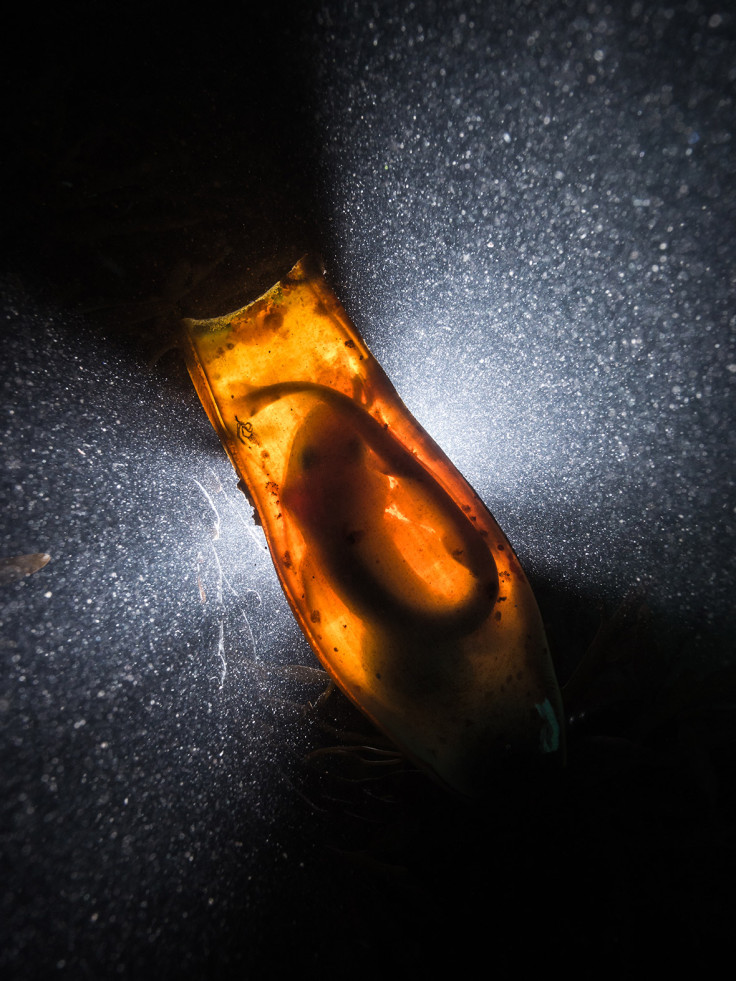
Up & Coming Underwater Photographer of the Year 2016
'Three Pillars - Practice, Patience & Luck!' by Pier Mane (South Africa)
"Weary of shooting sharks head-on, and keen to avoid diver's bubbles in my shot, I decided to turn away from the peak action and the crowds it attracts. I wanted sun rays, dramatic foreground, background perspective, and - the cherry on top - to capture the 'master of the house' in all of its mystique. The three sponges were well-positioned to set the scene beneath the boat and it took countless shots to balance the elements I wanted; but perseverance, patience and practice all paid off. I would like to dedicate my first winning shot to my father, for his introduction to photography, and to my mother for passing on her resilient attitude."
'Three Pillars- Practice, Patience & Luck!' by Pier Mane also came first place in the Up and Coming category.
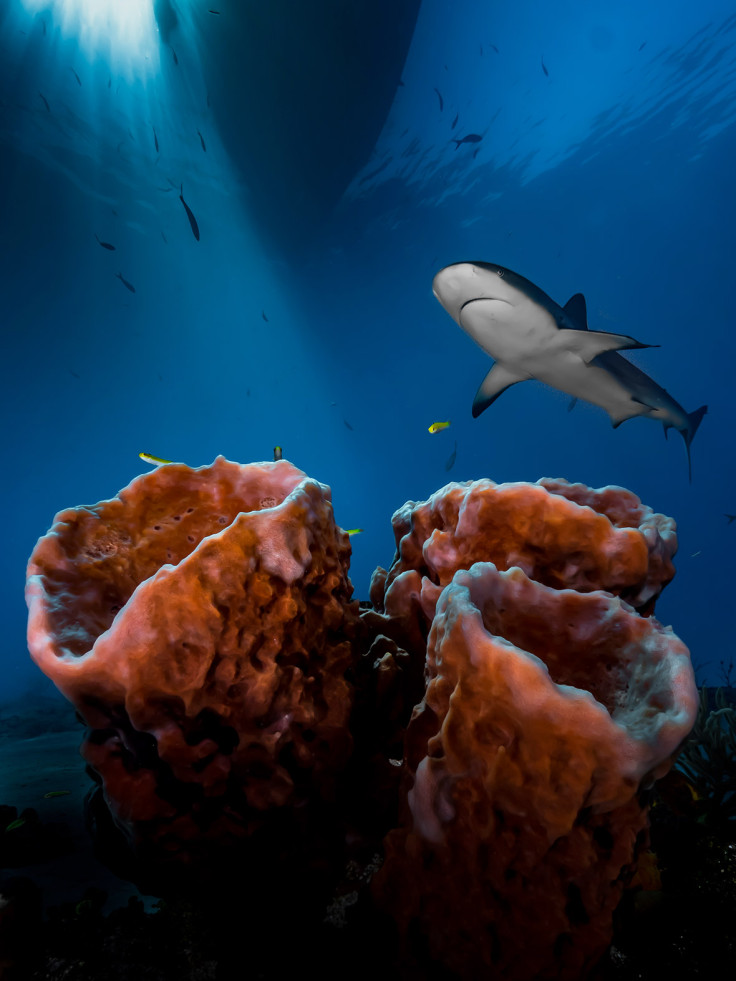
Most Promising British Underwater Photographer 2016
'Fired up and "almost" ready to go' by Marty Engels Dunmore (UK)
"Today it isn't easy to produce a unique image of this well loved wreck and I did a lot of research before I dived to see how others have photographed her before me. In 18m of Water I found this wonderful old machine, in fact there are two of these engines positioned opposite to each other. The Image is produced without any strobes, but with aid of my dive-torch, which I positioned within the engine to give me an extra focal point."
'Fired up and "almost" ready to go' by Marty Engels Dunmore also came runner up in the Up and Coming category.
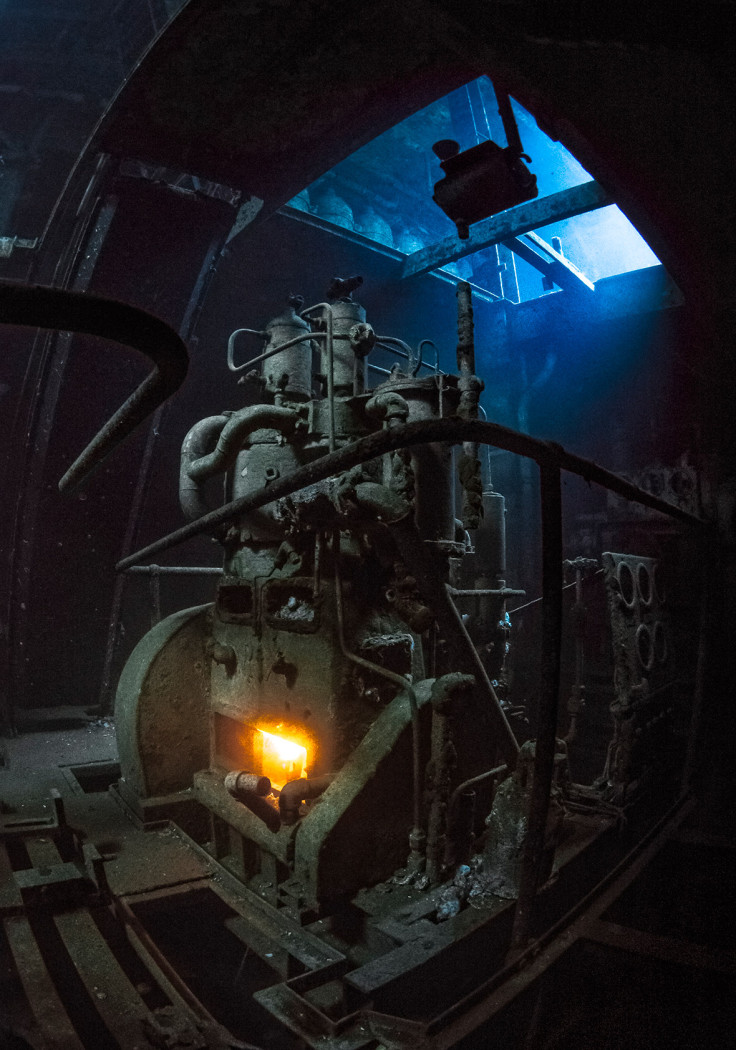
Wide Angle
WINNER: 'Underwater fisherman ' by Mike Korostelev (Russia)
"Cages are more commonly associated with photographing great white sharks, but I constructed a cage to keep me safe as I captured the fishing behaviour of the bear. I waited many hours in the cold water for the bear to come close enough to make my photo. The bear starts his fishing by sitting down, putting his head under the water and looking for fish. Once the fish starts to ignore him and moves closer he makes his crucial lunge to snare a large salmon in his paws, or teeth. He would usually stay underwater for about 20 seconds. This bear came to this place in the river several times a day. Each time he caught about five fish and then went for a rest on the beach."
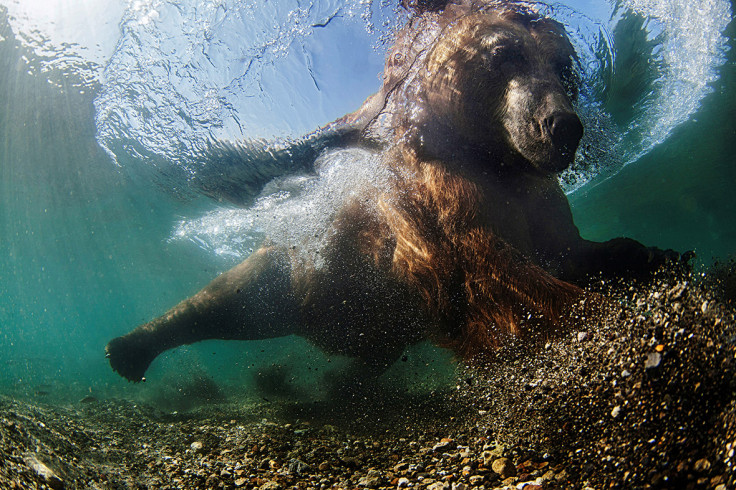
RUNNER UP: 'Mangrove sunset' by Fabio Galbiati (Italy)
"The first days the weather was bad and prevented us from going out with the boat to dive but we wanted to go into the water, why not take advantage of the pristine mangrove nearby? It was a big surprise, many subject everywhere and the light effects produced by the sun and mangroves were very special. I decided to make a shot at sunset, and after a long search I found the right root with this nudibranch (Jorunna funebris) intent on feeding. After framing to restrict the backscatter I only had to wait for the sun to do his duty and.... press the shutter!"
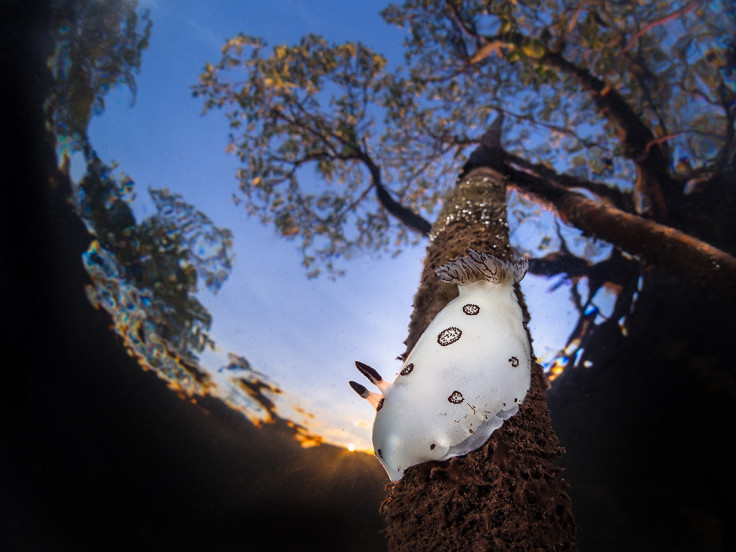
THIRD: 'Lagoon' by Greg Lecoeur (France)
"French Polynesia is an amazing place for nature lovers. In the lagoon of Moorea I was snorkeling with an abundance of marine life, most notably these black tip sharks. The topography of the mountains in the background inspired me to realise this half and half photo."

HIGHLY COMMENDED: 'Green Turtle with remora fish' by Barathieu Gabriel (France)
"Green turtles swim the reef flat to the beach N'Gouja. They spend much of their time feeding because this food is not very energetic therefore need a large quantity to meet their needs."

HIGHLY COMMENDED: 'Pilot Whales' by Greg Lecoeur (France)
"During a day sailing the Mediterranean Sea, I was very lucky to find a big pod of Pilot whales that accept me in the blue water. They were turning around me, it was an amazing experience and a great opportunity to photograph them."
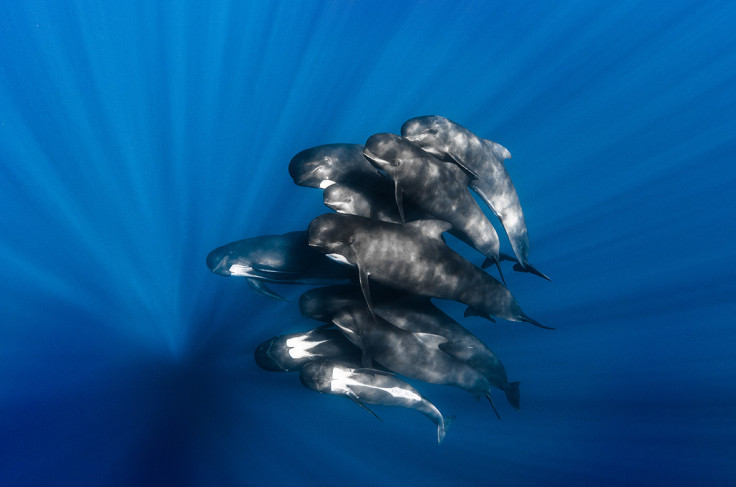
HIGHLY COMMENDED: 'Swim' by Davide Lopresti (Italy)
"I took this picture during the Swim the island, a competition of swimming in the sea, where contestants will compete over a distance of 6km, making a circle around the island of Bergeggi in Liguria. The photo was taken during the start, when the group is still compact and have not yet outlined the balance of the race."

HIGHLY COMMENDED: 'Beach Guardians' by Alejandro Prieto (Mexico)
"Playa del Carmen Quintana Roo Mexico. Returning from a dive with bull sharks I saw a beautiful flock of seagulls flying very low over a crowded beach. This white creatures are comfortable with human presence, they usually low and gentle fly over the people looking for food; this behaviour allowed me to try to shot them from beneath the water. I took me many times visiting the area and thousands of photos before getting it. With this photograph I want to show that ordinary subjects can become extraordinary depending on the perspective you see them."
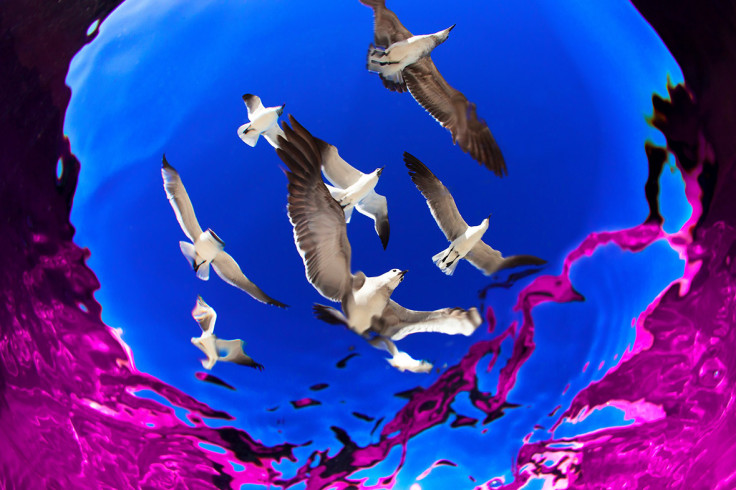
COMMENDED: 'Seven' by Mathieu Foulquié (France)
"Regarding this photo, I'm often asked if it is just a photomontage... nothing more easy indeed, with today's photo editing tools but there were really seven Caribbean reef sharks in the same frame. In the marine sanctuary of Gardens of the Queen in Cuba, sharks follow the divers during all the dive, up to surface where they swim in large numbers under the boat I just slightly moved away, to keep divers out of the frame, and only have sharks swimming in open water rays of light and clear water did the rest."
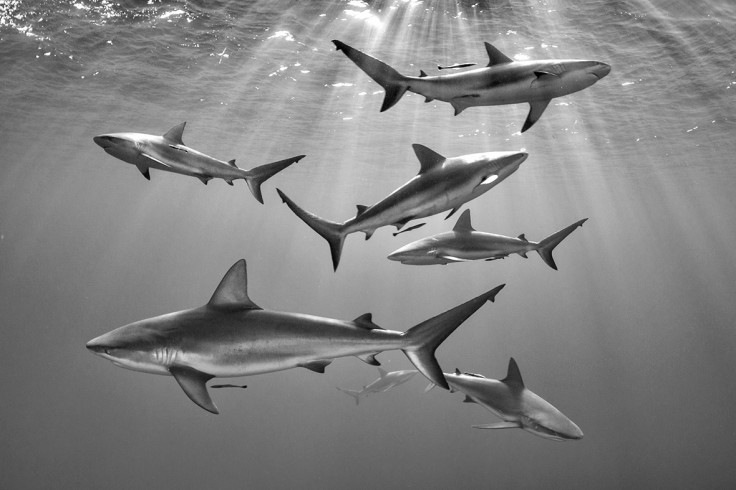
COMMENDED: 'Blue ballet' by Damien Mauric (UK)
"I like to create images showing marine life in motion and Raja Ampat is probably the best place on earth for creating this type of images. Every reef, every wall, every piece of rock is carpeted of an abundant marine life while there is always something happening in the blue. While I was exploring one of the underwater garden of Pulau WayiIbatan, I noticed this large and beautiful fiery-red gorgonian. Coming out of nowhere a huge school silversides started a beautiful choreography in front of my camera. What a perfect moment for the passionate diver that I am to witness this dance orchestrated by larger pelagic fishes hunting in the background. I couldn't miss the opportunity to capture the elegance of this underwater ballet."

COMMENDED: 'Icebreaker' by Tobias Friedrich (Deutschland)
"We planned to dive in April in Greenland to specially photograph the icebergs. In spring the visibility is very goof which results from the less influence of melt water out at the coast as well as the algal bloom starts only a few weeks later in the year. A bit of the 90% of the iceberg, which supposed to be underwater, can already be seen from the surface. The water is about -2C, but at the sight of the ice during the dive, the icy temperature can quickly be forgotten. The structures of the giant are shimmering blue-greenish in the strong sunlight.
"The colossus reveals unexpected forms: similar like a reef with canyons, coves and small plateaus, which extend far beyond the structures of part of the iceberg that can be seen over the water surface. In some places sharp edges like oversized axes rise from the ice and in others the ice is traversed by fine cracks that run like veins through it. Almost everywhere is a thin, only a few centimetres thick, transparent layer of ice over a solid white core that looks like snow. In these fantastic visibilities a safety line is no longer necessary, because at any time the boat can be seen from the depths, which follows the divers between the ice floes on the surface."
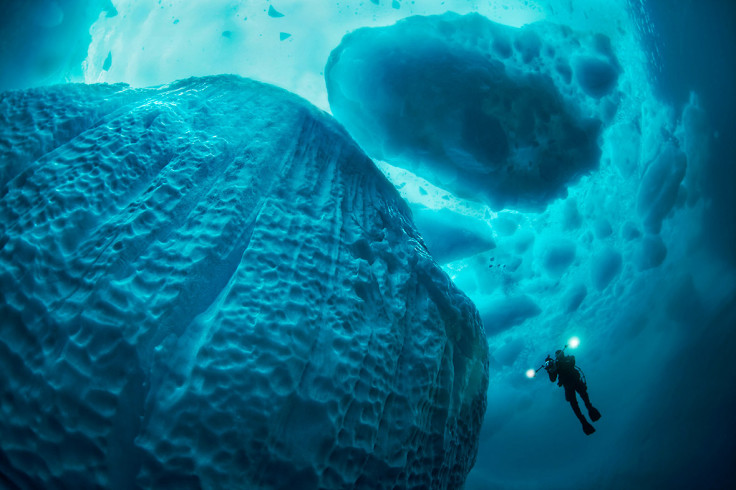
Macro
RUNNER UP: 'Pelagic Octopus at Night' by Helen Brierley (US)
"Suspended in the inky blackness of the open ocean where the water is thousands of feet deep, myriad weird and wonderful creatures came into view in the narrow focus light beam. They were making their nightly journey towards the surface to feed, before heading back down to the depths in time to escape the light of another day. Using our lights to help locate their prey, we were truly in another world, and we did not want to ever leave. I was able to take several shots of this tiny octopus as he drifted by, but he disappeared again into the darkness all too soon."
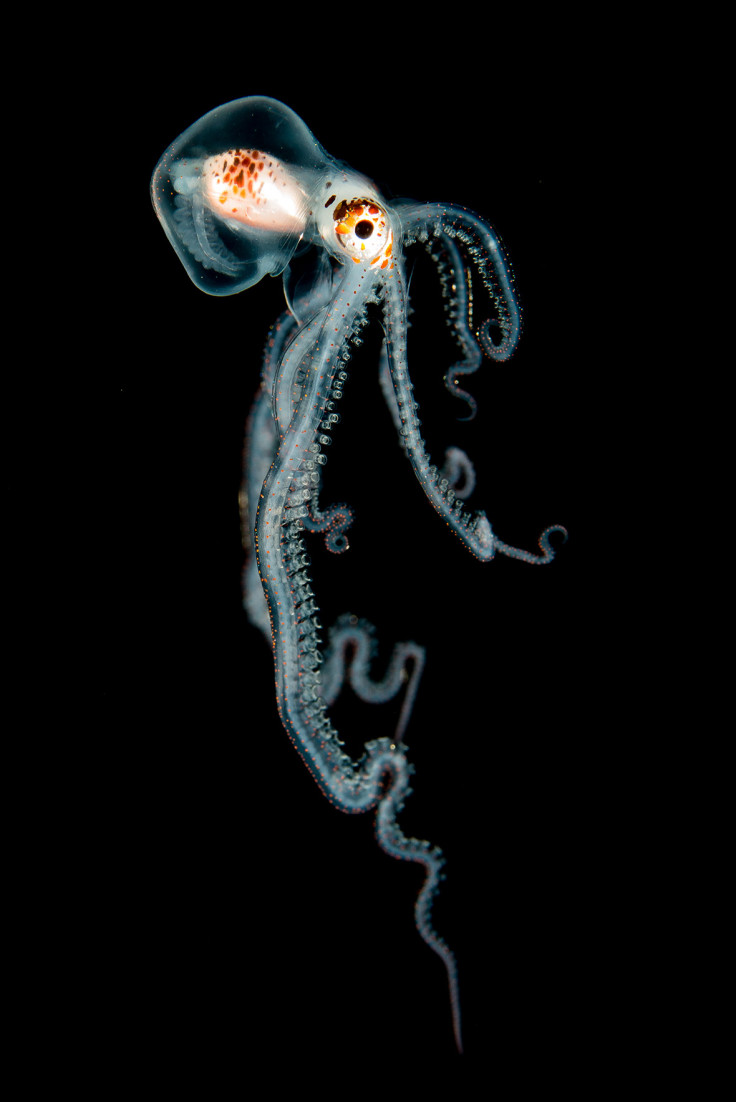
THIRD: 'The odd couple' by Gianni Colucci (Italia)
"During a night dive at around midnight with a full moon, I found this pair of sea horses (Hippocampus guttulatus), who swam in the shallows holding each other by the tail. The scene that I photographed was something magestic, a magic only enhanced by the beauty of the site and the evening's full moon."
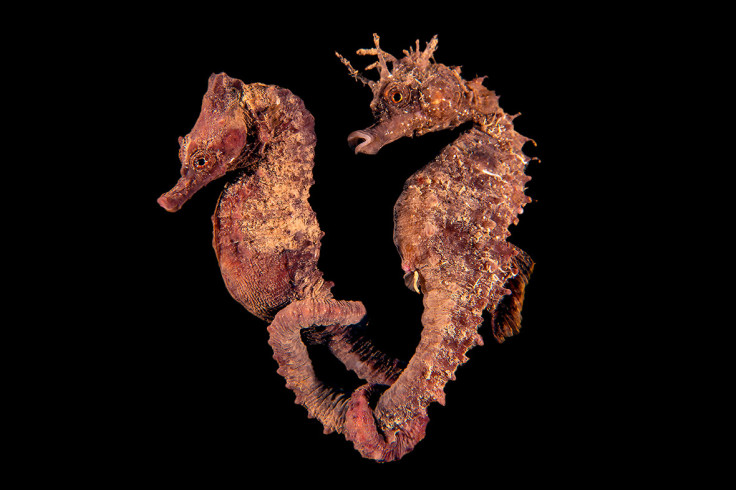
HIGHLY COMMENDED: 'Timeless Moment!' by Behnaz Afsahi (Canada)
"Jellyfish Lake was one of the highlights of my trip to Palau. Scuba diving is not allowed in this lake, so I was free diving when I took this photo. The thousands of jellyfish in this lake are simply breathtaking to behold, but made it challenging to find one in isolation. With the sunlight above me I finally managed to capture this single jellyfish, while the rays of light passing down through the water illuminated the multitude of its brethren, creating the backdrop I was trying to achieve."
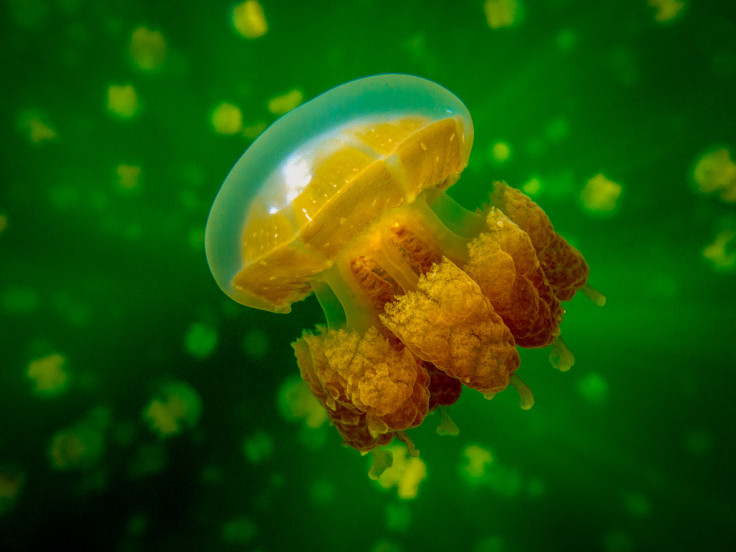
HIGHLY COMMENDED: 'Lace Model' by Qing Lin (Canada)
"This weedy scorpionfish was surrounded with many photographers when I found it. When it was my turn, I only had four minutes left before needing to ascend, so I took several shots in a hurry. I felt so disappointed and kept thinking about how beautiful it looked while. I decided to go back the following day. This also gave me more time to consider and manage a unique way to present her charm better.
"The characteristic of this fish is her beautiful lace, so I thought backlighting it would emphasize its details. I placed a light on the right back of this fish, facing left front and took several shots. While I was adjusting the settings on the camera, she suddenly turned about 80 degrees as can be seen on the picture. The angle, light and position were perfect. Click! What a smart fish, she definitely knows how to strike a pose."
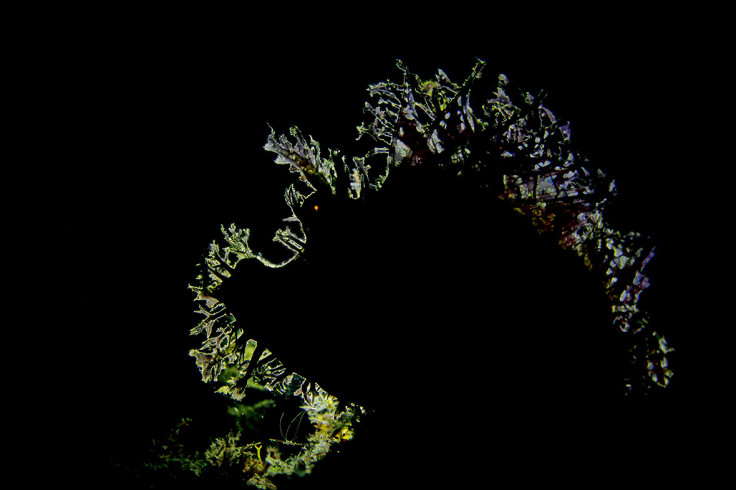
HIGHLY COMMENDED: 'Black water' by Greg Lecoeur (France)
"I have captured this image during a night dive in black water. Five miles off shore of Big Island, I was drifting in the current to witness the bigger migration in the world. Every night, the zooplankton migrates from the deep water to the surface to feed. Among the creature of darkness, this larva lobster is dragging pelagic jellyfish to eat them and to use their protection."
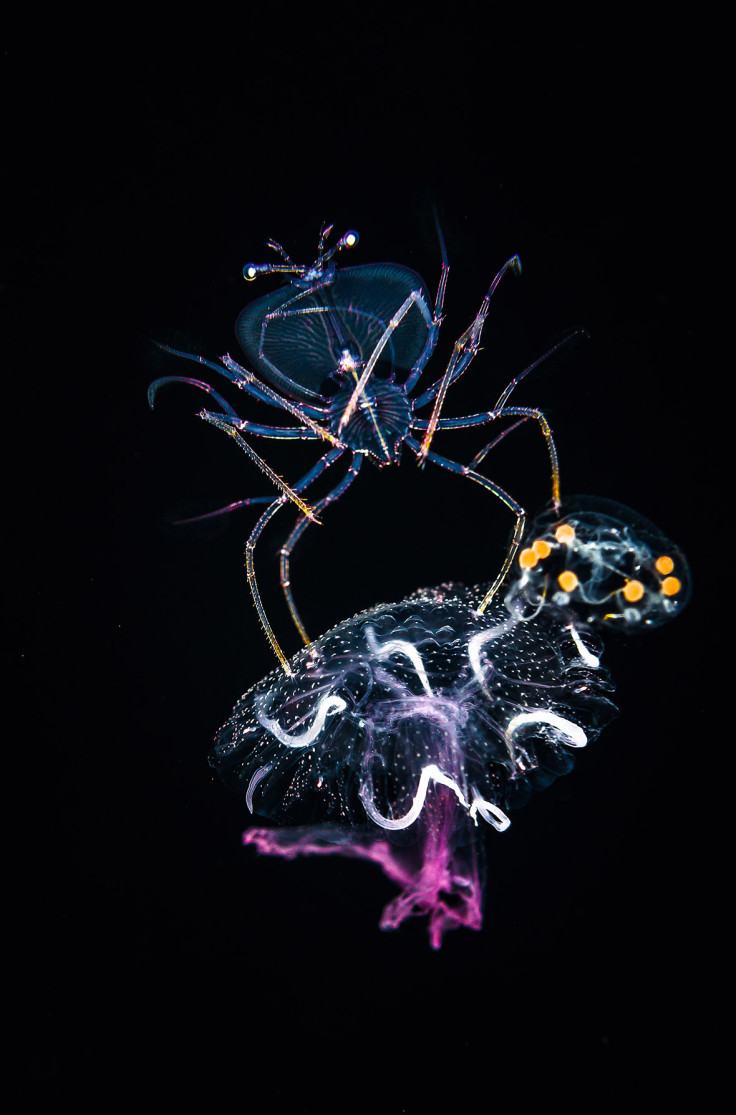
HIGHLY COMMENDED: 'Lightning' by Adriano Morettin (Italy)
"This photo was made with the technique of double exposure performed directly in the camera without changing the lens and making two consecutive shots. The first shot is done on the main subject with the help of a snoot applied on the flash to isolate the subject against a dark background and the second shot is made to the sun taken from below the surface. The difficulty lies in mixing the two shots to make it appear that it is a single-shot, without superimposing the two images and creating a pleasant scene and realistic.
"The Mediterranean shrimp Periclimenes amethysteus is one of my favourite subjects for the magnificent colours of his livery and so it is very suitable for pictures taken with the double exposure. Among the thousands of shots I've done to this kind of shrimp I think this is one of those most successful for the particular form of the sun in the background that looks like a flash of lightning."
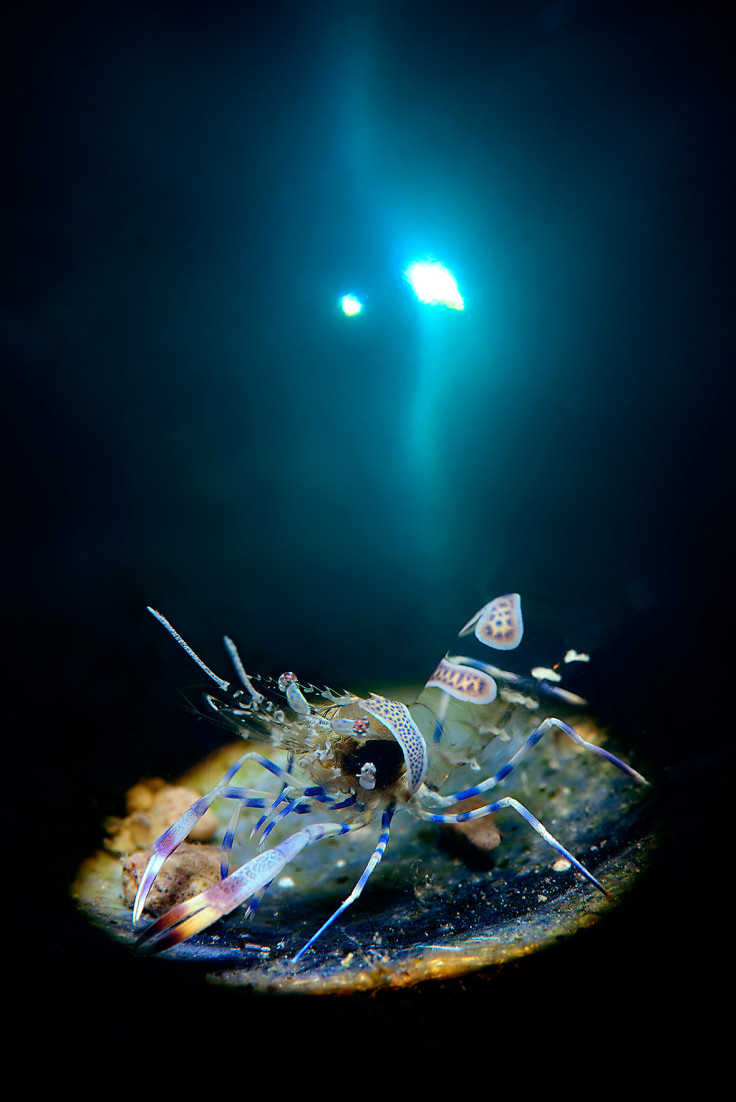
COMMENDED: 'Starry Weever' by Marc Casanovas (Spain)
"Sometimes there are animals that transmit their appearance or something that humanises reflecting part of his character. For Starry Weever (Trachinus Radiatus) of his head, with his mouth and his eyes convey an appearance of seriousness, of the aggressiveness of a predator waiting, patient, sand prey approaches. This was a photograph that by time I had in my head and after several attempts got the goal he sought. A front and symmetrical head shot in which I tried to highlight the morphology of isolating animal environment with a single illuminating flash overhead and with a snoot."

COMMENDED: 'Goby on a Sea Pen' by Ross Gudgeon (Australia)
"Gobies on sea pens and whip corals are a very common subject for macro photography and I'm always trying to come up with a new way of shooting them. I have had many attempts to get a shot like this with the snooted strobe either mounted on camera or off camera on a tripod but could never get the positioning of the narrow beam just right while trying to manage the camera as well. I was finally able to get the shot I wanted by using our dive guide to position the snoot where I wanted it leaving me free to concentrate on getting the shot."

COMMENDED: 'Spotlight' by matteo visconti (Italia)
"Harlequin shrimp (Hymenocera picta) is one of my best critters to shot because its colours and its shape. it is quite common to see in seraya secret and often they eating starfishes in couple. seraya secret is a popular dive spot in bali, it's located in tulamben area, bali's west coast, in my humble experience one of the three best muck dive place with anilao (philippines) and lembeh (indonesia). always in love with this shrimp i wanted to shot it in a different way, i love the snoot effect and most of my macro pictures are taken with it so i tried a different point of view shooting it from its side profile. using snoot allowed me to set apart the subject from background."
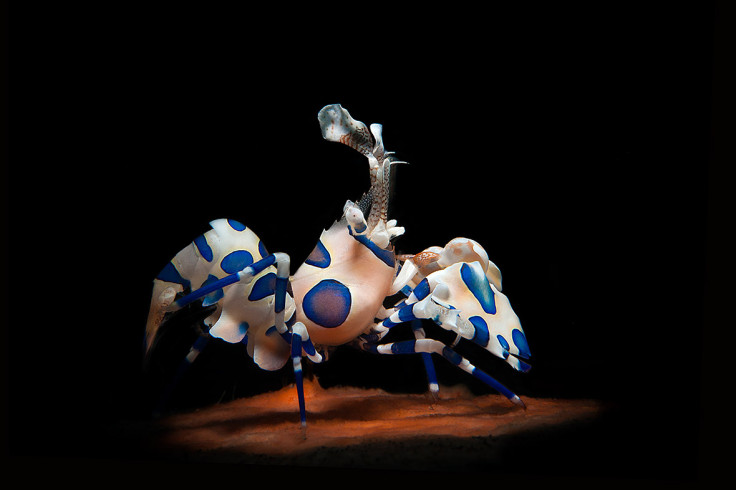
Wrecks
WINNER: 'A Family Affair..' by Thomas Heckmann (Germany)
"I was unable to descend because I had to take care of Maja, my five-year-old daughter who is unable to snorkel by herself. The only possibility was a shot from the surface under these circumstances. It was too rough for a normal over/under shot. I decided to try a wave and wreck shot with the island of Curacao in the background while swimming together with my daughter. I needed several tries to compose the wreck, the wave and the island in one shot. But at the end I got this real over/under shot with a total other view of the famous wreck."

RUNNER UP: 'Truck Parking' by Anders Nyberg (Sverige)
"I really like the SS Thistlegorm and can not get enough of this beautiful wreck. What makes the wreck so unique is the great opportunity to create stunning wreck images, especially if you add one or more off camera strobes to create more depth in the image. For lighting, my buddy and I placed the three off camera strobes, one strobe in each truck and a torch in the engine compartment in the first truck. I can easily spend the entire dive inside the wreck, important to remember when shooting in wrecks is to move carefully so you don't silt up the area when you are placing the off camera strobes thus ruining the image."
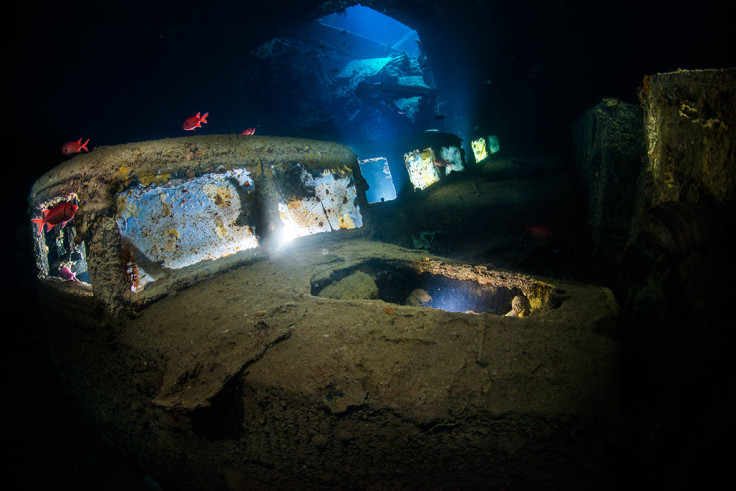
THIRD: 'Beaufighter' by Steve Jones (UK)
"This is the wreck of an RAF Beaufighter, a heavily armed attack aircraft used extensively in World War II. The wreckage lies upside down on bright white sand at 38m. I wanted to get an image of the whole wreck that was different from what I'd seen before and as my buddy moved near the undercarriage I realised that the best angle was from directly above. Our use of rebreathers made the task much easier, as I didn't have to worry about any annoying bubbles."
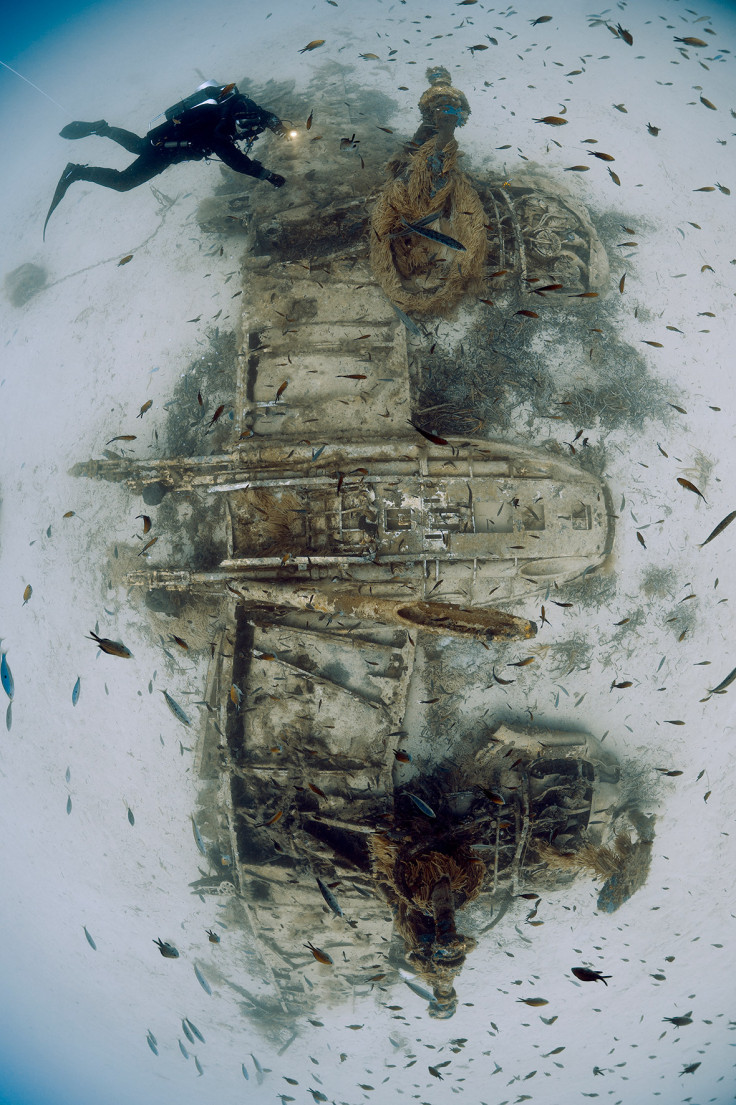
HIGHLY COMMENDED: 'Need to change a tire' by Anders Nyberg (Sverige)
"SS Thistlegorm is one big playground for underwater photographers to create good images. In the lower holds that contains several diferent truck models, you can find this Albion AM468 aircraft fueling truck, it is one of six trucks. With its characteristic box-shaped cabin, it is a beautiful object to photograph. To get to the natural light, I have chosen a slow shutter speed to take in as much of the natural background light as possible.
"I have two strobes on camera and has also placed an off camera strobes in the cabin to give the picture an extra dimension. I really like these pictures, I can easily spend the entire dive inside the wreck. I really like these pictures, I can easily spend the entire dive inside the wreck, important to remember when shooting in wrecks is to move carefully so you don't silt up the area when you are placing the off camera strobes."
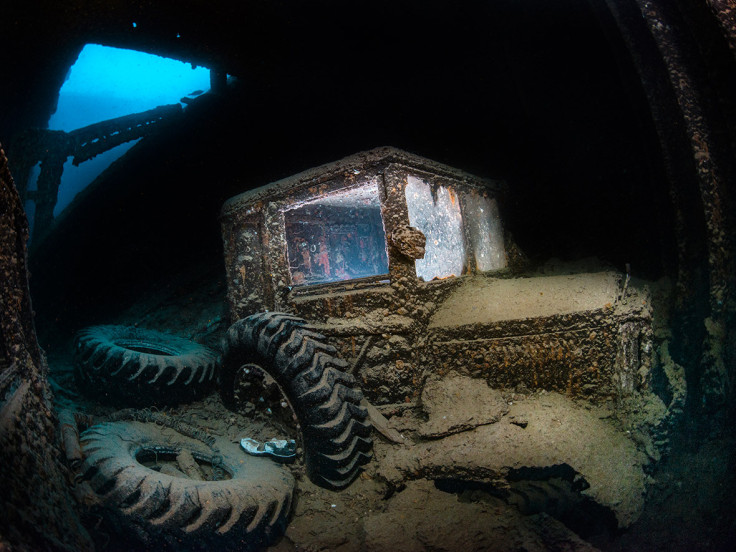
HIGHLY COMMENDED: 'The Tank' by Saeed Rashid (United Kingdom)
"The Tank as it's called is in fact an anti-aircraft US-built M42 Duster. Sunk in the 1980s by the now King of Jordan as an artificial reef. This unusual wreck sits in about 7m making it perfect for snorkeling and is often visited at the end or beginning of reef dives and easily accessed from the beach. Although small it teams with life making it a great place for both wide angle and macro photography. This image was shot bobbing up and down on the surface."
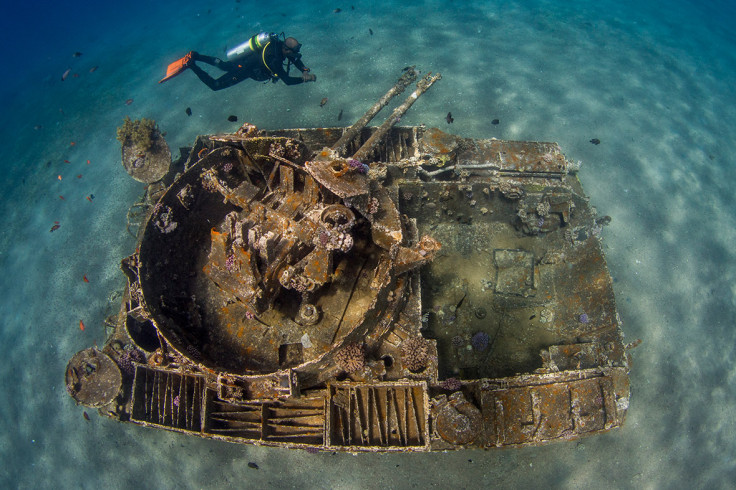
HIGHLY COMMENDED: 'Caribbean, Grand Cayman. USS Kittiwake and diver' by Christian Vizl (Mexico)
"This image was taken during a workshop given by David Doubilet and Jennifer Hayes at Cayman Islands. I attended the workshop and we visited many sites during our dives, including two dives at the USS Kittiwake. The diver in the picture is David Doubilet who very kindly offered himself as a model to his students."
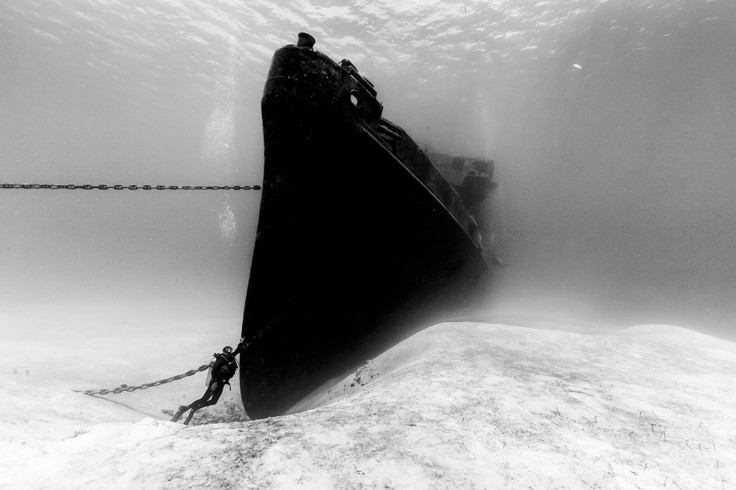
HIGHLY COMMENDED: 'Exploring the Podsnap ' by Spencer Burrows (UK)
"Living in the Midlands I am not blessed with living near the coast so often spend my weekends at local inland dive sites. I think the photographic potential is often over looked with inland sites, so I attempt to take images that showcase these sites in the best possible way. This particular wreck is a Dickens Class Harbour Minesweeper, built in 1944 specifically to clear mines in around harbour entrances during WWII.
"I particularly liked the angle of the wreck, and felt it could make an interesting composition as the perimeter of the wreck leads the eye in and out of the image. Using a wide angle lens I got close to enhance the size of the wreck. My dive buddy kindly offered to model for interest and scale using a dive torch. I processed the image using a monochrome finish which I feel lends itself well to the tonal range and also to add atmosphere to the image."
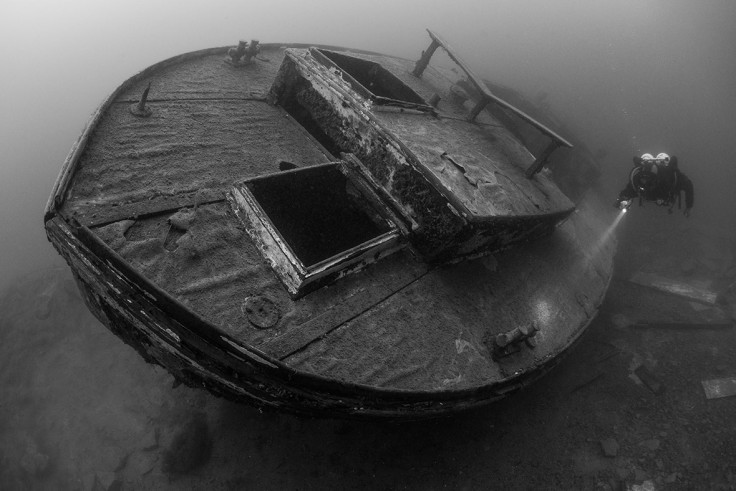
COMMENDED: 'The steering wheel' by Rui Guerra (Portugal)
"Diving in a huge war frigate, it is an unforgettable experience, even if the sinking have been deliberate, as is the case of 'Hermenegildo Capelo', which is part of Ocean Park Revival, in Algarve, Portugal. For several dives, I tried to create images that "brought back to life" the four ships, using remote flashes at various points. One of the emblematic sites is the bridge, especially its steering wheel, where in the past the captain have given orders for war, patrol or rescue missions, during the time that this ship was at the service of Portuguese Navy .
"To prolong the bottom time and minimize decompression, I've used a rebreather Poseidon MKVI Discovery, since it's a small unit, while working alone, to avoid stir up sediment. The dives lasted about 90 minutes, at depths up to 30m, often in confined environments such as the engine rooms and the holds."

COMMENDED: 'Rozi tugboat' by Trevor Rees (UK)
"The Rozi tugboat wreck at Cirkewwa in Malta lies on a sandy sea bed at a depth of 30m. It was a deliberately sunk wreck created as a diver attraction and as such is nicely intact boat sitting upright on the sea bed. A cooperate dive buddy has posed for me to add a bit interest and scale to the image. Visibility at the time was excellent and just available light has been used for exposure. Originally taken in colour, a monochrome conversion was made which I feel has added more drama to the shot."
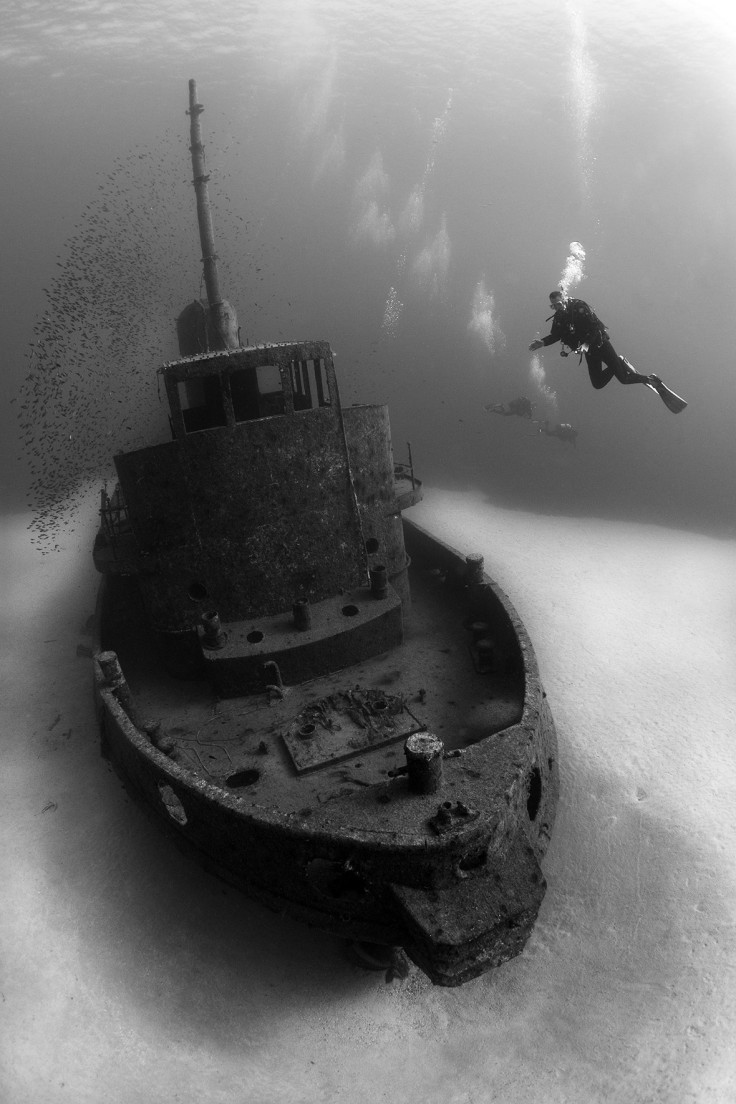
COMMENDED: 'USS Kittiwake shipwreck' by Susannah H. Snowden-Smith (Grand Cayman)
"I have taken lots of photographs of the Kittiwake where it fills the frame, or it's shot head-on. For this photo, I wanted something different; I had an image in my mind's eye and set off to capture it. I had decided to photograph the shipwreck from the side, and further away to reduce its size in the frame. The Kittiwake is a 251' long vessel and so I had to swim quite a distance away, turning around occasionally to check my progress.
"I had noticed the school of jacks and knew I wanted to incorporate them in the photo. So composition-wise I waited for them to be in the right place. Then I wanted a diver in the image for scale and additional interest. I only clicked the shutter when the diver's fins were close together; this makes for a clean look. Black and white completed the strong graphic image I was after."
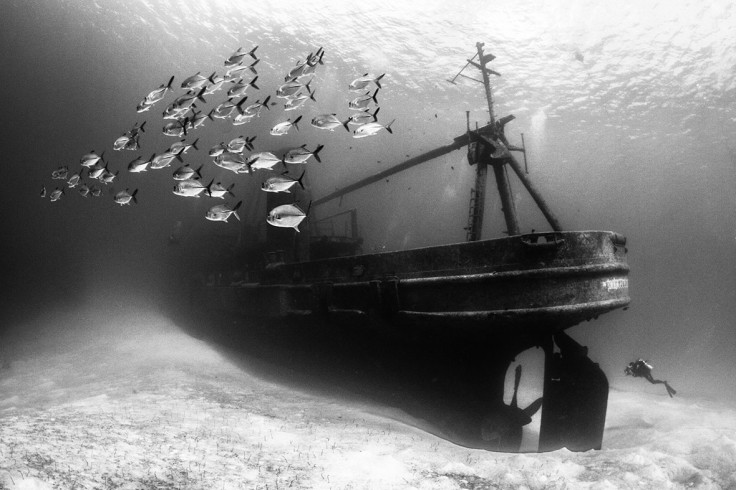
Behaviour
WINNER: 'Turtle eating Jellyfish' by Richard Carey (Thailand)
"After an early morning dive in the Similan Islands, we stopped in a bay to have breakfast. A Green Turtle (Chelonia mydas) surfaced near our boat. I decided to get in and snorkel with it, watching it as it searched for food. Soon it spotted a large Mosaic Jellyfish (Thysanostoma thysanura) swimming a couple of meters below the surface. It swam over to the jellyfish, dived down and started feeding on it. The turtle obviously wanted to keep the jelly close to the surface so every time it swam deeper the turtle would bite on to it and drag it back upwards. I spent a few minutes watching it and taking photos, and then left the turtle to finish his meal in peace."
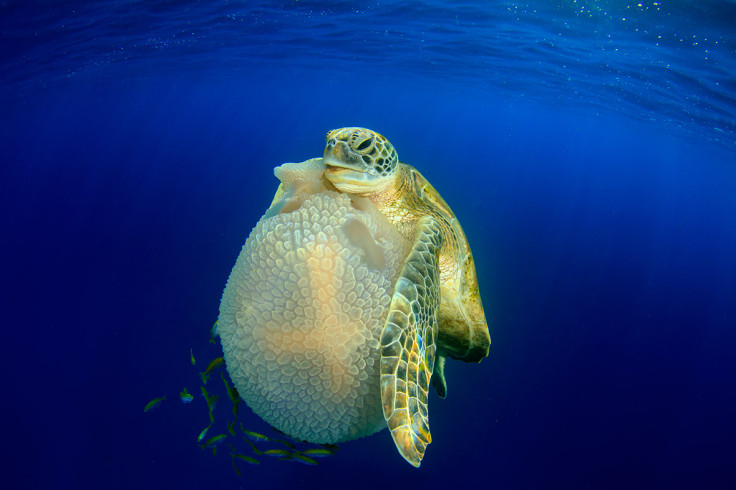
RUNNER UP: 'WHAT FEEDS BENEATH' by ALEJANDRO PRIETO (Mexico)
"I entered the cold November the water to photograph a pair of humpback whales which passed away very quickly, swimming back to the boat I saw a small moving object in front of me; it was a Hawaiian petrel submerging its head to feed on the tiny crustaceans. Under normal circumstances as you get close it will fly away, but surprisingly instead of this it just kept feeding in-front of me. By approaching very slowly I was able to get close from beneath, thankfully it stayed there for a few moments allowing me to capture this behaviour. The Hawaiian petrel is a species classified as endangered by the IUCN."

THIRD: 'Millions of crabs' by Rui Guerra (Portugal)
"Every year, millions of crabs (Polybius henslowii) form large red masses in places along the coast of Portugal. This high density of swimming crabs is somewhat rare to be seen and although we saw some dispersed crabs, it took us almost an hour to spot a higher concentration. It was after another 20 minutes of blue-water diving that I noticed an immense 'red cloud' made up of maybe several thousand crabs swimming through the water."
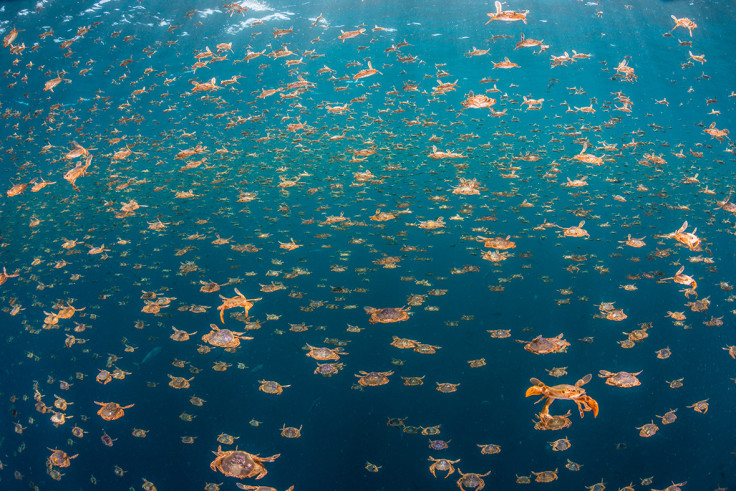
HIGHLY COMMENDED: 'Crunch' by Theresa A. Guise (U.S.A.)
"Isla Guadalupe is well-known for aggregation of great white sharks from August through January each year. From a surface cage on the Solmar V, I was observing five great whites feeding on tuna served up in the water when, out of the blue, a turtle entered the mix. The sharks paid little attention to the turtle until it tried to eat the tuna, at which time the sharks nudged it away from the food. The turtle kept returning to eat the tuna, only to be bumped away several times. Finally, the turtle saw a piece of tuna floating near my surface cage, and started to eat it.
"A great white followed, and bumped the turtle away one final time. When the turtle returned, an exasperated shark grabbed the turtle with its massive jaws and a loud 'crunch' was heard as far down as the 30 foot submersible cage below. The shark then spit the turtle out, and the turtle swam away. Pre-crunch images of the turtle showed that the turtle already had a cracked shell and suggest that this turtle was no stranger to the bite of the great white shark."
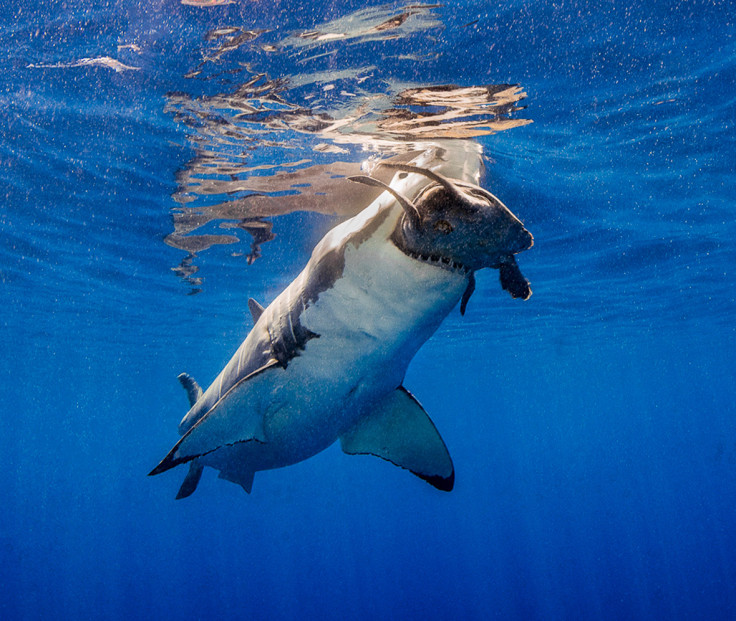
HIGHLY COMMENDED: ' Pair of fish cleaners in action on parrotfish' by Paolo Bausani (Italia)
"A year ago, during a trip to Indonesia, I stayed for about 10 days in Walea archipelago Togian. Up from the first dive House reef directly from the Resort I noticed a massive presence of cleaning stations. Numerous fish cleaners engaged with reef fish in a few meters deep. The situation was fantastic. After you locate the right area with a lot of patience I waited for the favourable moment to shoot. For about two hours still to not disturb such a wonder I have tried the appropriate time to document everything. In turn, but also in pairs, fish cleaners alternated on parrotfish, after these with their powerful beak had crushed coral in search of polyps. All this every time lasted a few seconds but enough to make some shots interesting."
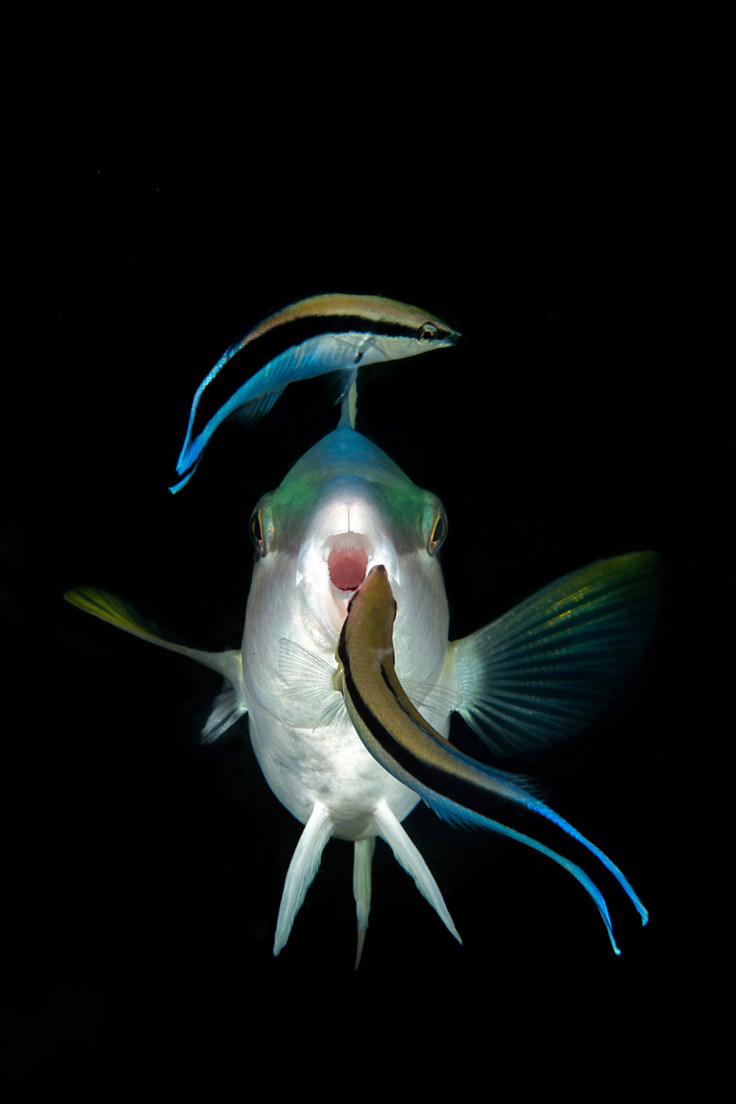
HIGHLY COMMENDED: 'All-you-can-eat eggs buffet' by Vania Kam (Hong Kong)
"When I found this nudibranch (Favorinus tsuruganus), it was lying on the rock inside the eggs. Tried a few 'normal' shots and didn't like the effect. It then starting crawling around the eggs and then back to the wall and then back to the eggs slowly and I knew I wanted it standing right in the middle as if it was looking out of the window so I waited and waited and it finally walked to the exact position where I wanted it to be. I then adjusted my strobes on both ends of the eggs so the thick layer of eggs would block the lights out creating this dramatic effect."

HIGHLY COMMENDED: 'Hunting Long Nosed Hawkfish' by Damien McGuirk (Ireland)
"I love looking for Longnose Hawkfish. In the Maldives, the place to look for them is in the bushes of Black Frondy Coral. They are very skittish subjects at the best of times, some will swin off, and some will hang around. This little guy didn't mind me looking at him, and only by studying him over a few minutes did I sense he was doing something unusual. Without warning, he shot off his perch to return a few seconds later with something in his mouth. I aimed my camera as best I could, and tripped the shutter. It was only later when I reviewed the image in my hotel room did I realise what I had actually captured."

COMMENDED: 'Battle at the Nine.' by Ralph Pace (USA)
"Nine miles off the coast of San Diego, CA is a high spot called the Nine Mile Bank. A great area to encounter pelagic animals in blue water. With much of the bait having moved north due to the warmer water El Nino regime, The Nine has been very different this year. As we were driving along we saw birds and a commotion at the surface. We quickly realised it was a sea lion eating a mola, not a sea lion's common fare. It was incredible scene. We watched for 45 minutes as the mola tried to evade the sea lion. The sea lion was able to finally penetrate the mola's tough skin and feed on the mola's caloric rich inners. Here, as they look eye to eye in all the chaos, the mola seems to plead for it's life."
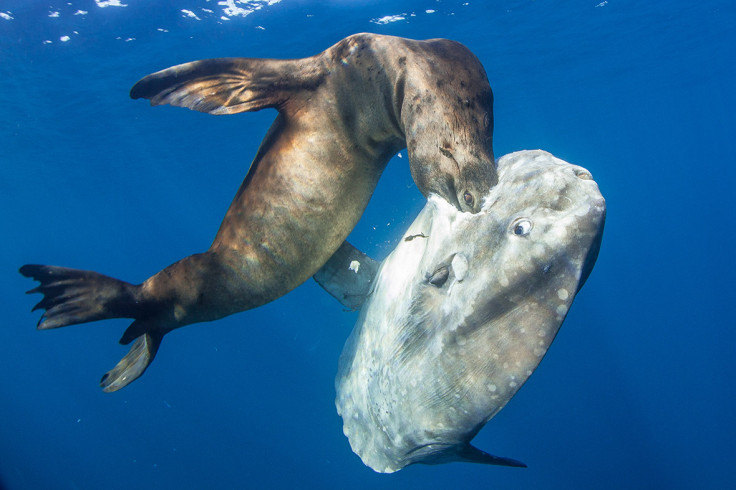
COMMENDED: 'Life Begins - Bumphead Parrotfish Spawning' by Richard Barnden (Palau)
"Around the new moon thousands of Bumphead Parrotfish (Bolbometepon muricatum) gather at a special site in Palau for only a select period of time for the sole purpose of spawning and continuing their species. To be able to witness this exact timing takes a formula of tide, moon and light. It took me about a year of trying different lens combinations to finally get something I was happy with. The fish were always aware of my presence and getting close without disturbing their natural behavior was a challenge, especially as they were moving quite fast most of the time. On this particular dive all the factors came together and I was able to be in the right place at the right time as a spawning rush came from below straight towards me and broke apart, spawning right in front of the camera."

COMMENDED: 'Torrent' by Susannah H. Snowden-Smith (Grand Cayman)
"The silversides usually descend on Cayman once a year; it's an exciting time for us underwater photographers. They fill dark swim-throughs and caves with their reflective, wriggling bodies, and are hunted by larger fish; exciting photo opportunites! I headed to Cheeseburger Reef, where I heard they'd been sighted. Jacks and tarpon were feeding on the little silver fish, chasing them through the dark tunnels. I was making passes through the swim-through, framing and photographing when I decided to try something different. I chose a slow-exposure to show the movement of the silversides, and used my strobes to both reflect off them, and highlight some of the red sealife on the wall above. I positioned myself near the mouth of the tunnel to silhouette the larger fish as they hunted. When a jack chased silversides into the middle of this scene I had my shot."

Up and Coming
THIRD: 'The eye of a Butterfly ' by Spencer Burrows (UK)
"While masked butterflyfish are fairly common in the Red Sea, they are quite skittish and often swim away on approach. As I wanted to try and capture this common fish in a different way I had an abstract shot in mind and I felt the eye with its blue and yellow surroundings were key to the shot working. Having failed to get this to work with a standard macro lens, I equipped a tele-converter for additional reach which allowed me to keep my distance from the fish."
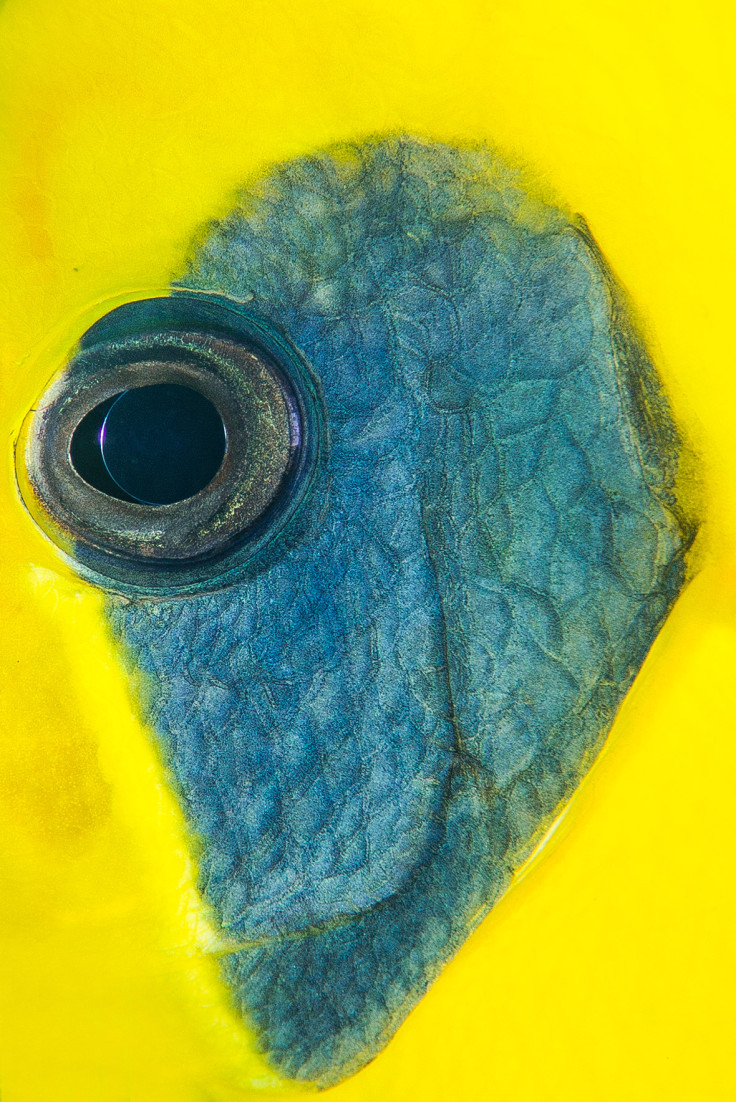
HIGHLY COMMENDED: 'The Great Sea Eagle' by Pier Mane (South Africa)
"Living for a while in my youth in south-east Alaska, I came to appreciate the Golden Eagle, a majestic creature oft-admired for her dazzling aeronautics and airborne confidence. Alas, I was then ill equipped to portray such splendour and supremacy of the skies. In previous underwater forays, I had depicted turtles as peaceful, graceful 'cuties', while they are actually among the sea's most resilient creatures.
"Hatched into a world in which one in one thousand reach maturity, sea turtles face increasing human demand for their meat, eggs and shells, rendering most species at risk of extinction. Inspired in this very moment by the Alaskan Golden Eagle, I seize upon this shot of the critically endangered hawksbill sea turtle. In Sodwana Bay, South Africa, under a moderate current and scarce light, the creature reveals a nature transcending mere gracefulness: confidence, born of longevity against all odds, and a seeming sense of itself as among the most magnificent denizens of the sea."
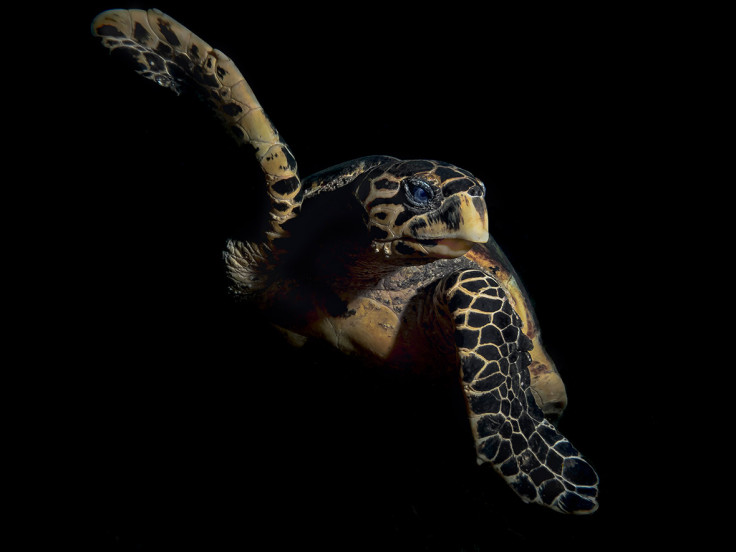
HIGHLY COMMENDED: 'Carribbean Reef Sharks ' by Marty Engels Dunmore (UK)
"Caribbean Reef Sharks, Image taken in Jardines de la Reina, Cuba. Jardines de la Reina is a 120km-long mangrove-forest and coral-island system situated 80km off the south coast of Ciego de Ávila province and 120km north of the Cayman Islands. The local marine park measures 3,800 sq km, with virgin territory left more or less untouched since the time of Columbus. I simply loved being in the water with this gorgeous predators and in the Jardines de la Reina you can meet many shark species in Abundance, always a Garant for a healthy reef system, I dearly wish we would have much more of this healthy reefs around the world."
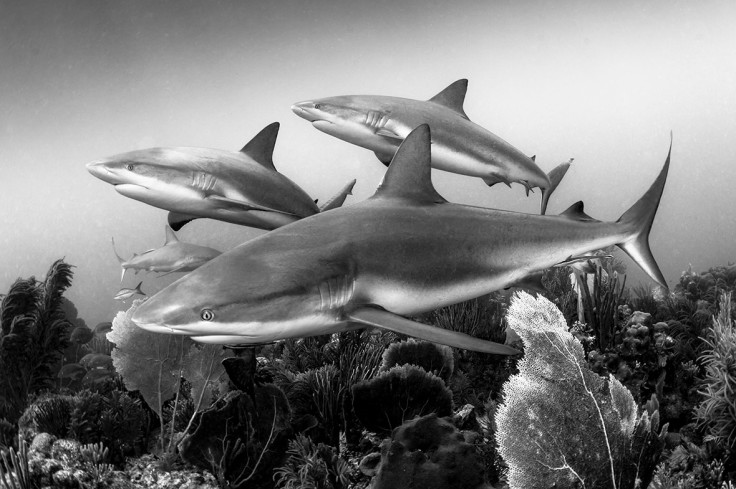
HIGHLY COMMENDED: 'Transparent Trick' by ifj. Lorincz Ferenc © Hungary (Hungary)
"We found the morray at a late afternoon diving with my diving buddy, with the cleaner shrimps on his head. I spent a lot of time waiting for him to open his mouth wide so I could take a photo of it. This did not succeed however... Right after I let my photographer buddy use the Murry as a model, he opened his mout. When my buddy was done taking photos, he let me get back to our model, but by that time, the morray had his mouth closed again."
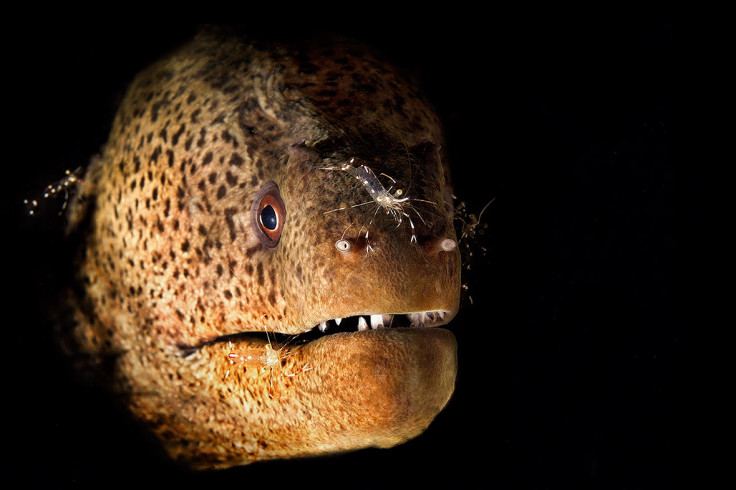
HIGHLY COMMENDED: 'Bass' by Oliver Anlauf (Germany)
"In a public pool in Hamburg our bassist went under water. The biggest challenge was the uplift, so we fastened lead weights under her clothes and at her ankles. We drilled holes into the bass, so that it could fill with water. Her makeup consisted of special waterproof paint. In order to put her into the perfect light, we set up two Arri-18 KW-lights at the pool's edge. All procedures were closely discussed with her in advance before we went into the water accompanied by safety divers. The underwater communication happened only with gestures. The shooting itself had to happen very fast and to the point, but we all had great fun and the results speak for themselves."

COMMENDED: 'White-spotted fighter' by Fabio Russo (Italy)
"Callistoctopus macropus, also known as white-spotted octopus is a species found in shallow areas of the Mediterranean Sea, the shot is made in a little harbor near Sorrento by night. When I took this shot I was very close to the octopus and, perhaps annoyed by the strobes, it jumped to attack the camera, so i had this strange position of the octopus just just before it grabbed with its tentacles housing. I am always very fascinated by cephalopods and the way they interact with the underwater photographer."
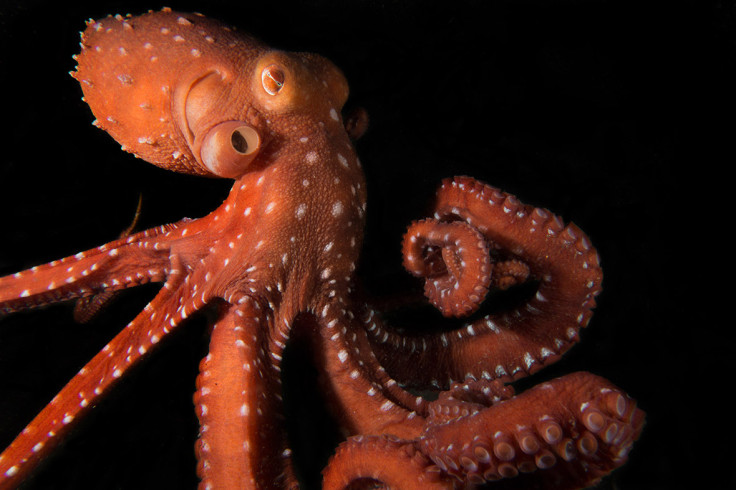
COMMENDED: 'The Majestic Purple Dame' by Pier Mane (South Africa)
"The eastern South Africa coast, widely known for large predator sharks, whales, dolphins and sardine, can sometime deliver incredibly unexpected surprises. Open-water diving at Protea Banks searching for hammerhead schools, my eyes fall upon a sizeable and animated figure. Unable to identify it from afar, I slowly approach to face the largest jelly fish I've ever seen. Her purple head and yellow fuselage where off the Lightroom™ saturation slider scale—even before I shot! With no background objects present to provide prospective, and wishing to exalt this crown jellyfish (Cephea) in all its stunning colors, majestic size, and dancing elegance, I opted for an explosive silhouette against a midday winter sun."
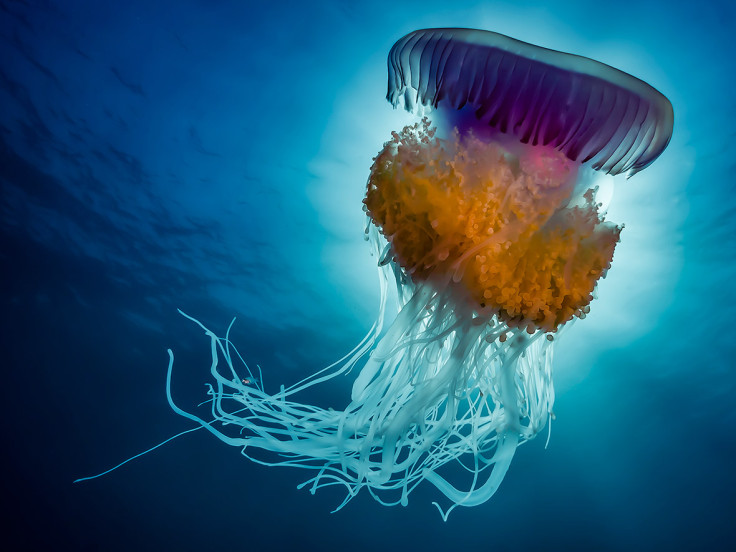
COMMENDED: 'Lighting the Cockpit' by Spencer Burrows (UK)
"Stoney Cove is a popular inland dive site that attracts thousands of divers each year, meaning it is heavily dived and photographed. I prefer to dive here over the winter when the site is less busy and improved water clarity. I wanted to capture an image that was a little different to that usually seen from this site and an original composition. I used an off camera strobe to internally light the cockpit and didn't opt for a head on composition. I opted for a side on profile at a diagonal angle as It suited lighting the internal part of the cockpit. I lined up the windows to add additional depth to the image, my buddy kindly modelled with a torch to add scale & context to complete the image."
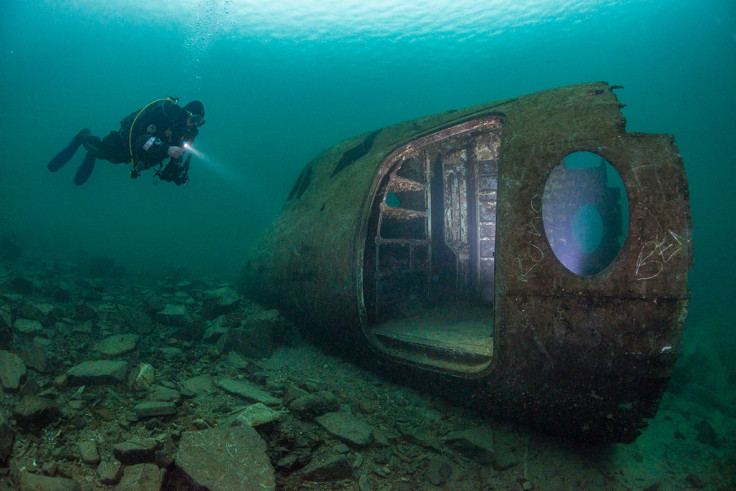
British Waters Wide Angle
WINNER: 'Part of the Illusion' by Marcus Blatchford (UK)
"The National Dive & Activity Centre is the deepest inland dive centre in the UK. The day the photo was taken, the dive plan was to bimble around the deep end, a dive we had done many times before but this time I dived "un-plugged" and using no artificial light. With the exception of a variation of camera technique, there were no planned shots either my buddy or I wanted to achieve - just a fun dive with ad-hoc photos along the way. Shortly after this photo was captured, in six-degree water and two hours of decompression ahead of us, we turned and started the long ascent back to the surface."
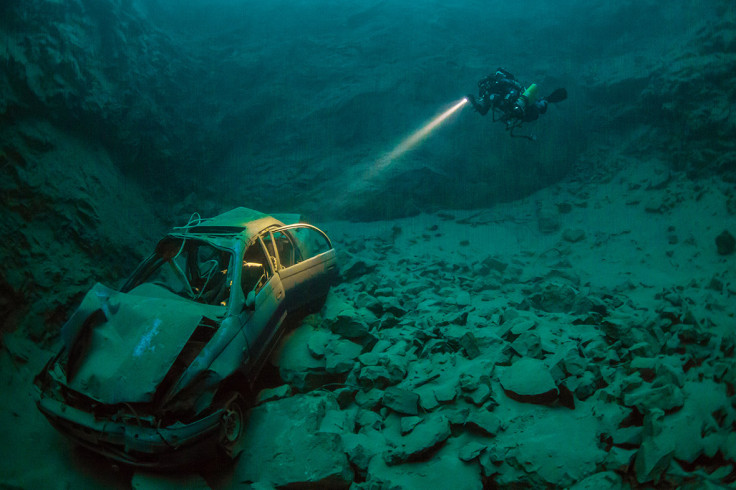
RUNNER UP: 'Shocked Shark' by Will Clark (UK)
"This juvenile Blue shark was the first to arrive at our boat after an hour of chumming. We were alerted to its presence by the bobbing of a small buoy which had fresh mackerel tied to it. I leaned over the side of the boat with my camera housing not quite fully submerged as the skipper tried to coax the shark nearer to the boat. He got the Blue very close to me, and then just at the last moment he whipped the bait out of the water which got a reaction from this little shark."
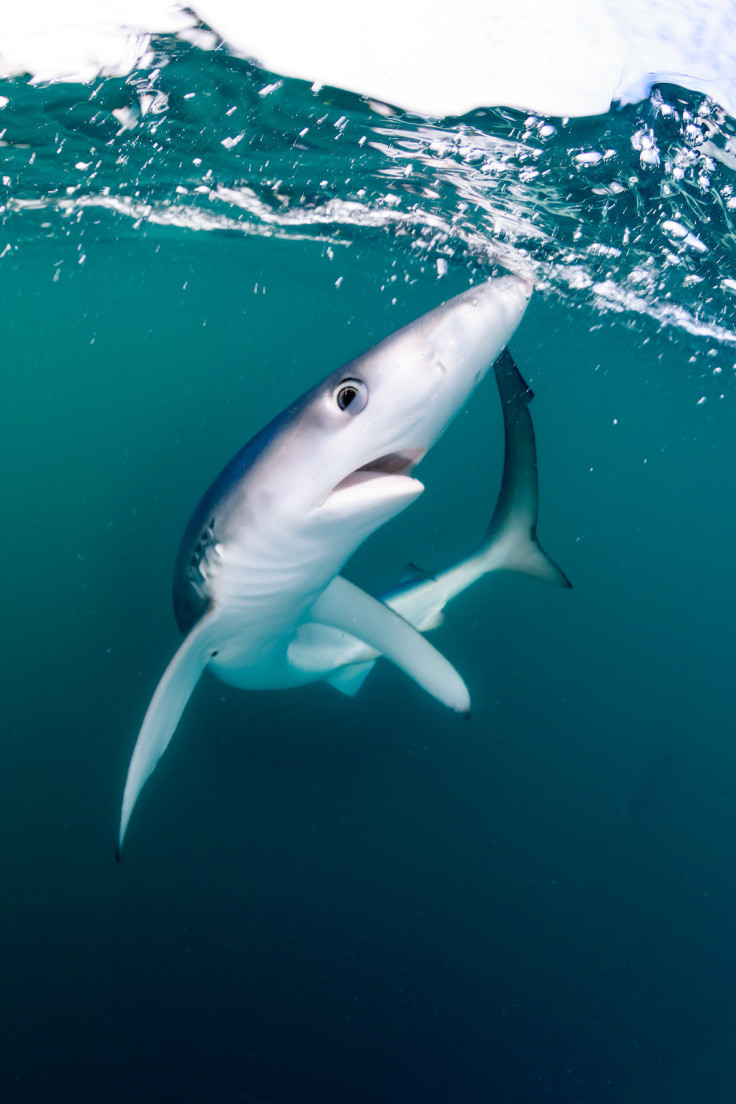
THIRD: 'Elan valley trout in winter' by Trevor Rees (UK)
"This is a half and half scene taken on a snowy January morning in the Elan Valley. I have used my fisheye lens behind a large dome port for ease of creating the split image. The depth of the water is no more than 30cm and the brown trout (Salmo trutta) has been subsequently added to the scene in Photoshop so this is very much a composite image. The trout is actually shot at a completely different time and location. The inspiration for the image may be from images I have seen of migrating salmon struggling up a river to then be found lying exhausted in the shallows - a poor substitute I know, but I like the effect."

HIGHLY COMMENDED: 'Set the Ray to Jelly' by Nick Blake (UK)
"Lundy Island in the Bristol Channel is a Marine Conservation Zone and a magnet for marine life. My reason for being there was Lundy's famous Grey Seals and on my first day, surprisingly they were missing. In their absence, I noticed small Comb Jellies suspended in the water. It was now mid-afternoon and with the sun still strong through the shallow water, I began experimenting in lining up a Comb Jelly in front of the sun, curious as to whether the camera's dynamic range could hold the scene. Swaying around in the gentle swell for the rest of the dive, I waited for the sun, Comb Jelly and myself to align, fascinated by the iridescent spectacle in the viewfinder. As cloud, rain and Seals returned for the second day, the opportunity was no more and I felt my time with the Comb Jellies and sunlight had been well spent."
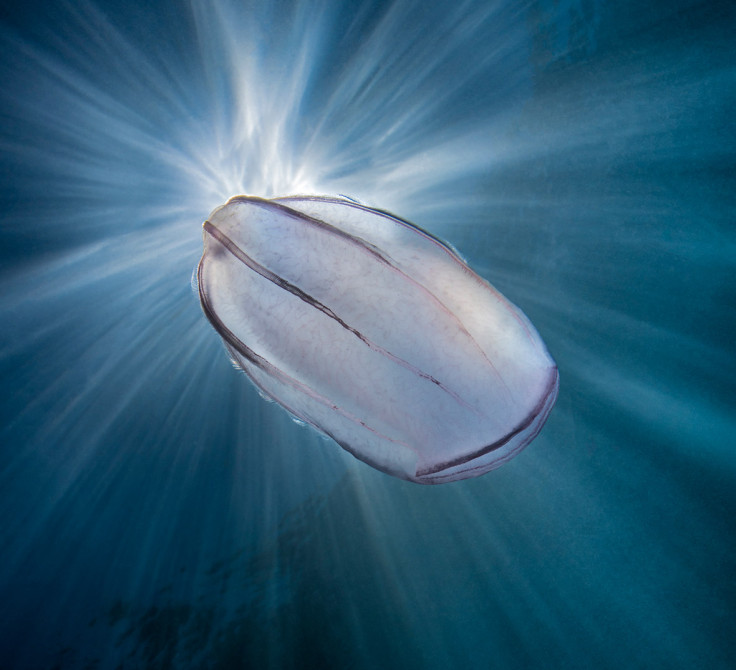
HIGHLY COMMENDED: 'Inquisitive flatties' by Richard Shucksmith (UK)
"The seas around Shetland can offer stunning visibility with abundant marine life. I had joined a trip onboard the M/V Halton, owned and skippered by Bob Anderson. Bob had been on Shetland all summer, running week long charters out of Lerwick. As always the banter started and Bob showed me an image he had taken on the Fraoch Ban, a small fishing vessel that had sunk when it had been over-laden with sand eels. Bob's image had several flatfish in the foreground with the wreck in the background. I commented how nice the image was so Bob said he would drop me on the wreck so I could have a go. In the water at 30m the white sand reflected the light making it very bright, and as I settled down, the flatfish started to move toward me. I spent the remainder of the dive waiting for fish to move into good positions to get the image I had in mind."
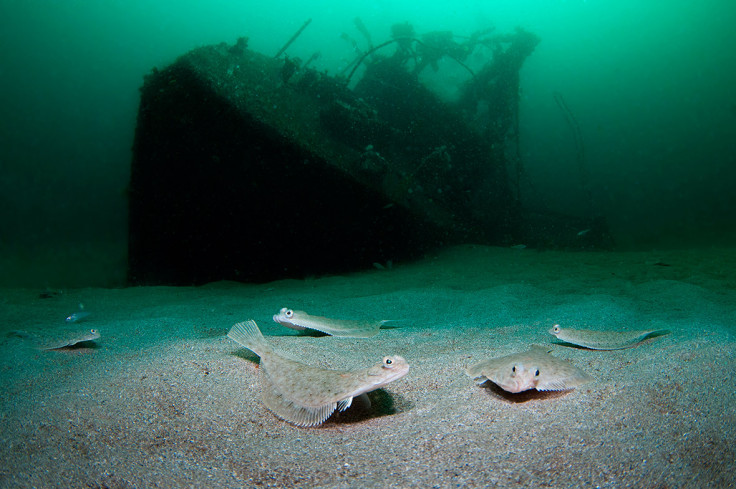
HIGHLY COMMENDED: 'Tadpole shoal' by Matt Doggett (UK)
"I was looking out for ways to test my new Nauticam housing early last year. One lunchtime I found a shoal of many thousands of toad tadpoles streaming along the margins of a wildlife pond near where I worked. The visibility was only around six inches but I thought it was worth a go! Over the next week I returned whenever the sun shone and experimented with different settings and lens combinations until I found something that worked. Every time I placed the camera in the water the tadpoles instantly swarmed all over it so I had to repeatedly lift it in and out the water, which in turn disturbed the nice neat shoal. It took a lot of failed efforts just to get this shot but it gives a nice idea of a tadpoles' eye view on the world."

HIGHLY COMMENDED: 'Discovery' by Steve Jones (UK)
"The aircraft pictured is a BAe 146 which was sunk as a diver attraction at the National Diving and Activity Centre in Chepstow, UK and lies at a depth of 27 meters. I wanted to create an image with a 'diver/discovery' type feel to it. BBC wildlife cameraman Doug Anderson, is aiming the light that's illuminating the aircraft and the late afternoon December surface light provided a nice dark grey/green ambience to surround the wreck. Doug is using two immensely powerful Orcalights producing a combined 44,000 lumens of light! I took several shots in the sequence, while Doug moved the lights back and forth so I could find the beam angle and exposure settings that worked best. We'd been in the water a long time, so the biggest challenge was fending off the cold."
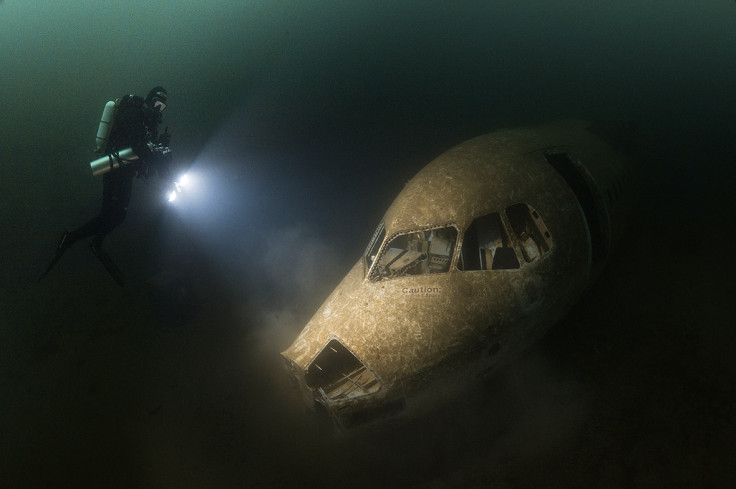
COMMENDED: 'Pike in quarry' by Trevor Rees (UK)
"Each winter when the water is cold, the visibility is often at its best and so I always try to get out and photograph these impressive fish. Pike (Esox lucius) are a top freshwater predator and a popular sight at a number of UK lakes and quarries. Stoney Cove in Leicestershire in England is a reliable place to see big specimens and even on a busy Saturday morning with hoards of divers stirring up the underwater visibility I usually manage to find a quiet corner to see how close I can get to them. The background scene in these quarries is often rather unexciting but I liked the huge triangular lump of rock as a backdrop to this pike."
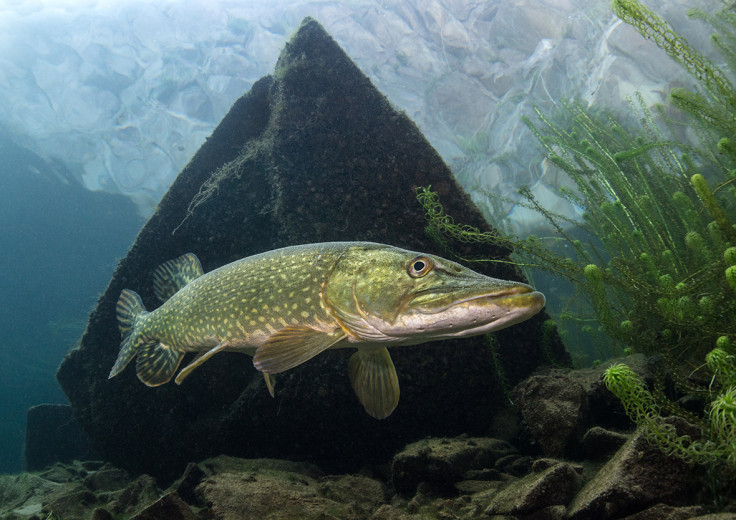
COMMENDED: 'Blue Blur' by Will Clark (UK)
"Our skipper Charles Hood had attracted five hungry Blue sharks to his boat by submerging a sack of frozen rotten fish to create a tempting downstream trail of smelly oils and particles. I'd already captured a few shots that I was happy with by leaning over the side of the boat so decided it was time to get in the water with the sharks. The dramatic atmosphere of this image was produced using a technique I learned from Dr Alex Mustard, who in turn had been inspired by an epic shark photograph by Tobi Bernhards.
"It involves using a relatively slow exposure with a bright flash at the beginning to capture the sharp elements then quickly panning the camera in front of the subject to create the naturally lit blur behind it. Doing this with the camera on a slight angle added another level of complexity but after many failed attempts I eventually got the shot that I'd visualised."
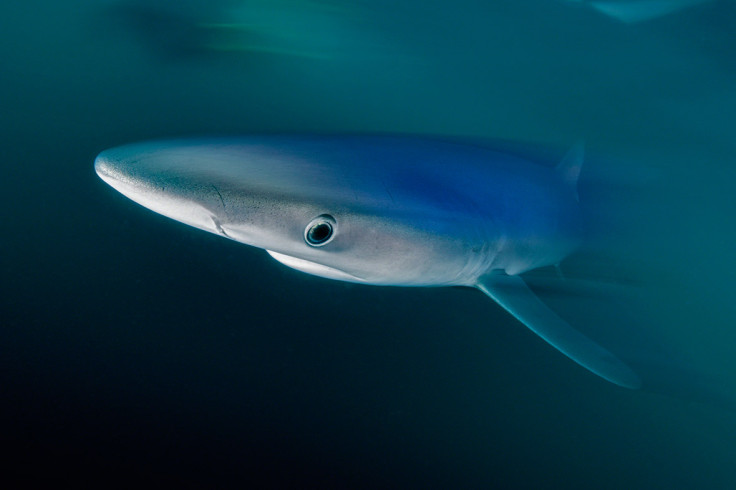
COMMENDED: 'Early morning plumose anemonies' by Dan Bolt (UK)
"Just off the beach at this popular diving spot there is some old rope that came off a crab-fishing pot some years ago. One end of the rope is wedged in the rocky seabed, the other has a float attached which keeps it upright at about 4m off the bottom. This old rope is home to a dense colony of plumose anemones, and in the early morning light of a summers day they are a joy to photograph."
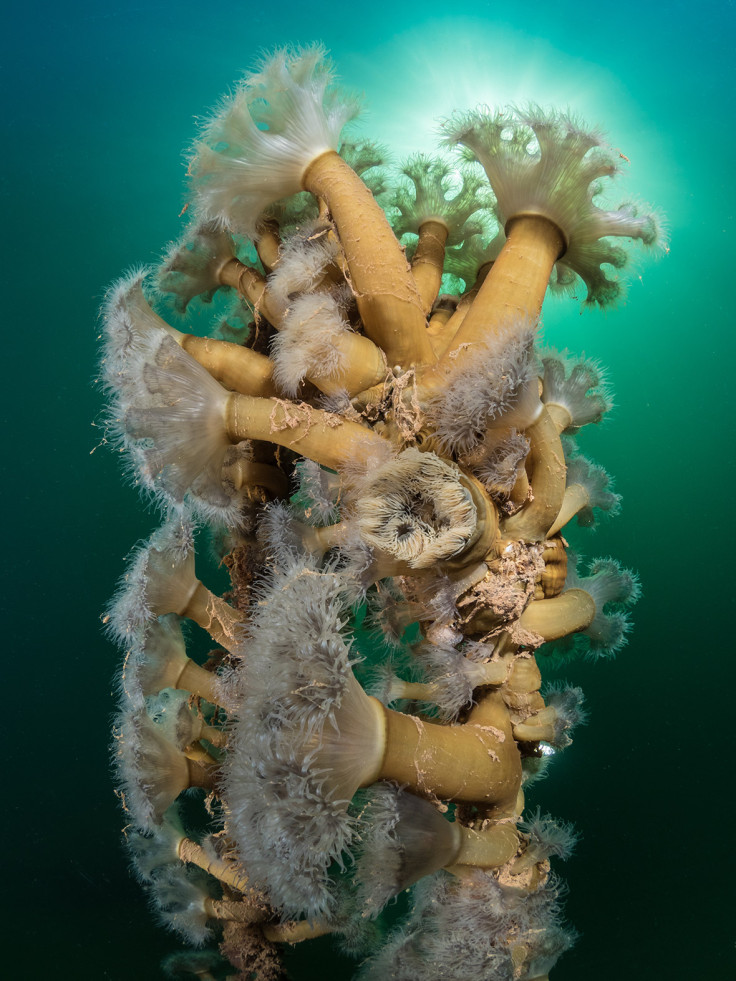
British Waters Macro
RUNNER UP: 'Planktonic Predator' by George Stoyle (UK)
"In the summer of 2015 Scottish Natural Heritage a Dive Team to conduct site monitoring of Special Areas of Conservation (SACs) which included North Rona which is where this image was taken. We had come to the end of a dive inside a cave, just before we reached the surface we noticed an unusual amount of zooplankton which had become trapped inside the cave entrance. We then spotted a couple of tiny, post-larval monkfish feeding on the plankton, something none of us had ever seen. Getting an in-focus shot with my macro lens was easier said than done with prevailing swell, but I managed a few before the boat came to pick us up."

THIRD: 'Safe haven' by Cathy Lewis (UK)
"It was our first dive of the season, on the wreck of the Scylla in Whitsand Bay near Plymouth. The water was thick with plankton and a strong current was funneling small compass jellyfish towards the starboard side of the wreck. Some of the jellyfish were host to a large number of juvenile codfish, possibly whiting, which use them for protection. The larger fry were perched on top while the smaller ones swam amongst the tentacles, somehow avoiding being stung. Photographing the highly reflective silver fry was a frustrating challenge, but I have never seen so many fish crammed into such small jellies so I knew I was witnessing something rather special."
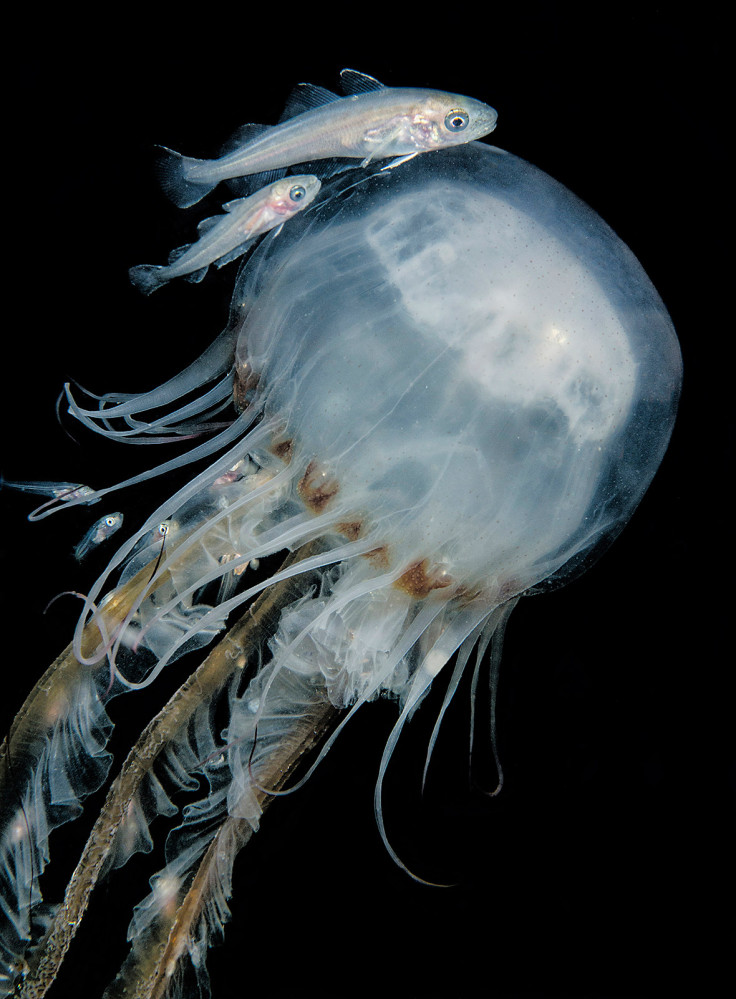
HIGHLY COMMENDED: 'Shanny' by Mark N Thomas (UK)
"Shanny are widespread and common fish, often seen by divers, hiding in nooks and crannies on rocks and piers. Their mottled colouring provides excellent camouflage. They are very inquisitive and when approached with care will often come out of their hiding places to investigate the strange bubble blowing creature trying to take their photo. This nosey little shanny was one of several hiding in a small breakwater in the shallows off Criccieth beach. I spent some time at the end of a warm, summer dive watching these shanny wriggling around the barnacle covered structure. After a while they overcame their fear of me and my cumbersome equipment and I was able to take several close up photos of this charismatic little fish."
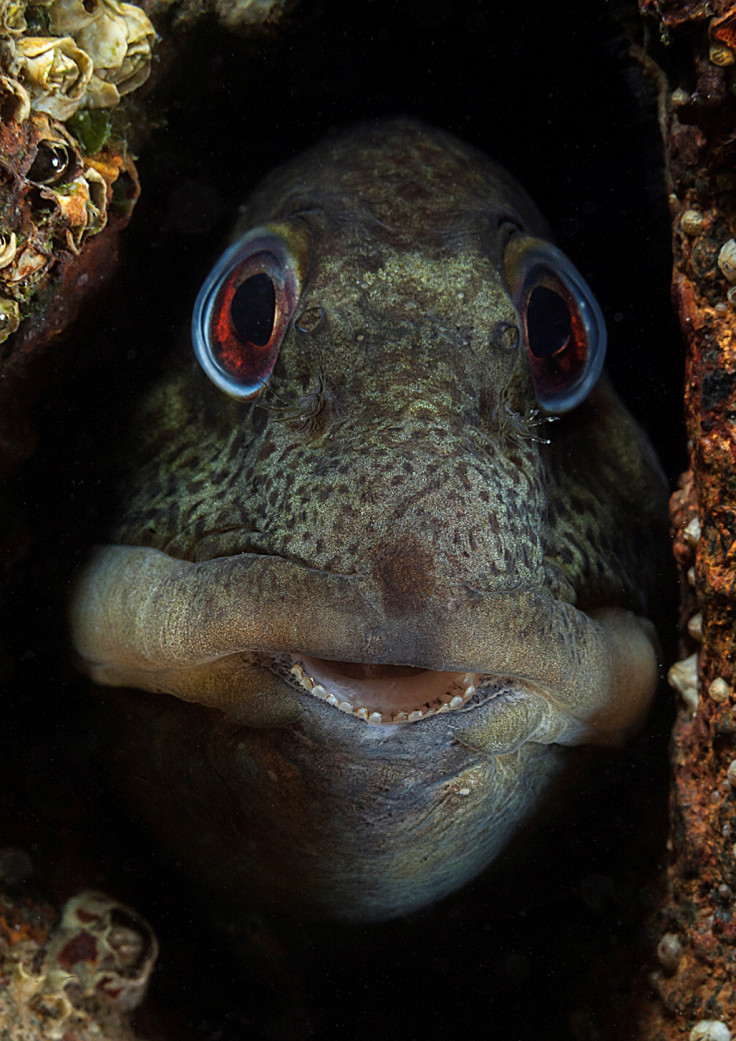
HIGHLY COMMENDED: 'Slug' by Alex Tattersall (UK)
"This delightful little guy was on a strand of kelp at 15m in a gulley of the south coast of the UK. It was an emotional experience all round."

HIGHLY COMMENDED: ' Angel' by Richard Shucksmith (UK)
"In the summer of 2015 Scottish Natural Heritage commissioned Heriot-Watt University's Scientific Dive Team to conduct site condition monitoring of Special Areas of Conservation (SAC'S) which included sea caves around Scotland's remotest islands, St Kilda and North Rona. I was asked to join the trip as one of two photographers. The three-week trip took us from Orkney across the north coast of Scotland, out to the Hebrides and on to St Kilda where this image was taken.
"Myself and my colleague, George Stoyle were swimming into an entrance of a sea cave to undertake photographic transects when I noticed several of these animals in the plankton. The impulse was to stop and photograph these wonderful creature but we had a job to do in the sea cave. After completing our tasks, we were making our way back out the cave and I was scanning the water column looking for this pteropod, known as a sea angel (Clione limacina) a pelagic sea slug. Right at the entrance I saw one in 5m of water, managed to take eight images before it was time to surface and be picked up by the boat."
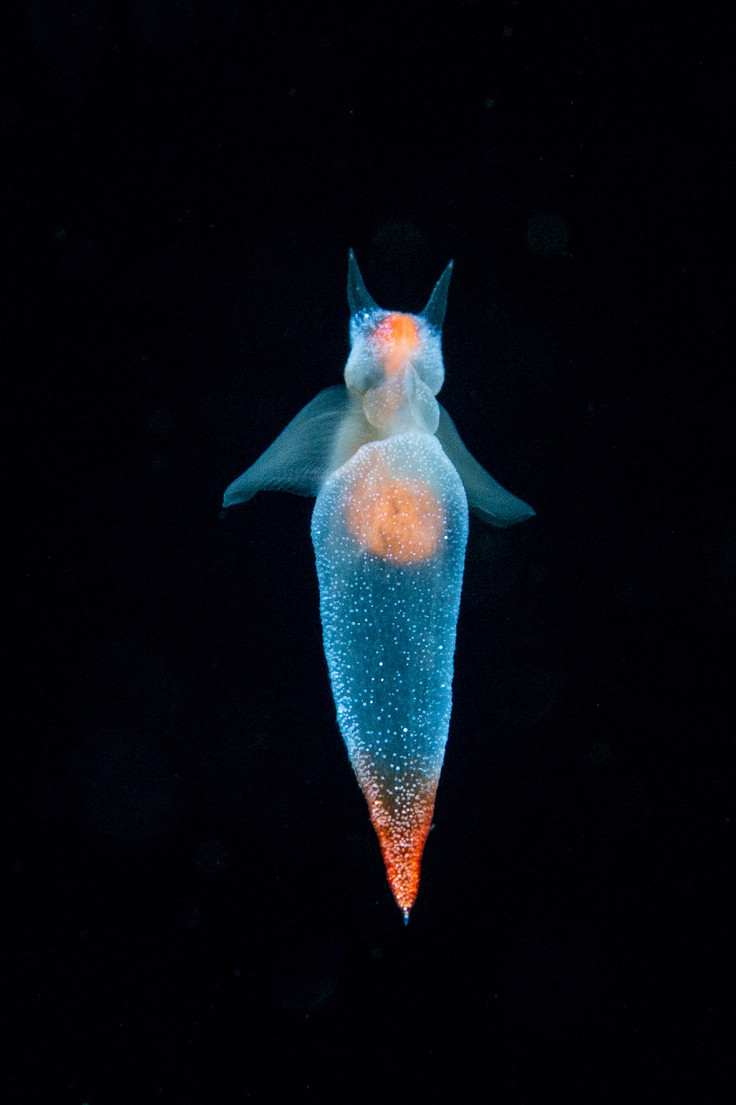
HIGHLY COMMENDED: 'Skeleton shrimp' by Trevor Rees (UK)
"This is a skeleton shrimp (Caprella linearis) is perched on the hydroid (Kirchenpauria similis). It is a small crustacean, about 2cm tall and is very easy to swim over and never notice. This yellow coloured individual caught my eye as they are generally white in appearance where they are then far more camouflaged against their familiar hydroid habitat. They are actually very common subjects indeed but are not often photographed well in UK waters. I was pleased to get one facing me in an upright position."

COMMENDED: 'Intruder beware' by Cathy Lewis (UK)

COMMENDED: 'Inquisitive Cuckoo Wrasse' by Saeed Rashid (UK)
"Wrasse are amazingly inquisitive fish and Cuckoo Wrasse even more so if you find the right individual they can stay with you for the whole dive. This guy was fascinated but something on my housing and everywhere I turned he was in front of me. This allowed be to get some portrait images of this lovely colourful fish which really stand out among other British species."

COMMENDED: 'Friend or Foe?' by Dan Bolt (UK)
"Having found a lumpsucker (Cyclopterus lumpus) tending to his newly laid eggs in the early spring, I made several visits back to the site over the coming weeks to study the development of the juveniles within the eggs. On this occasion there was a long-clawed porcelain crab (Pisidia longicornis) seeming poised to eat some of the young. Taking my time to observe, it turned out that the crab was actually helping to keep the eggs clean of parasites by eating them off the egg casings. A most fascinating behaviour to watch."

British Waters Compact
WINNER: 'Hello Ducky!' by Paul Colley (UK)
"While trying to photograph trout during a year-long river project with a home-made pole-cam, a raft of Mallard ducks muscled in to steal food intended to entice trout to the camera. This initial nuisance became an interesting opportunity and, shooting blind with the camera on the pole, I managed to catch the trout below water with a duck swimming overhead. Snell's window was an important pre-determined part of the composition. This needed a low viewpoint, an upward camera angle and a metric tonne of patience to allow all the elements to come together and make the picture work."
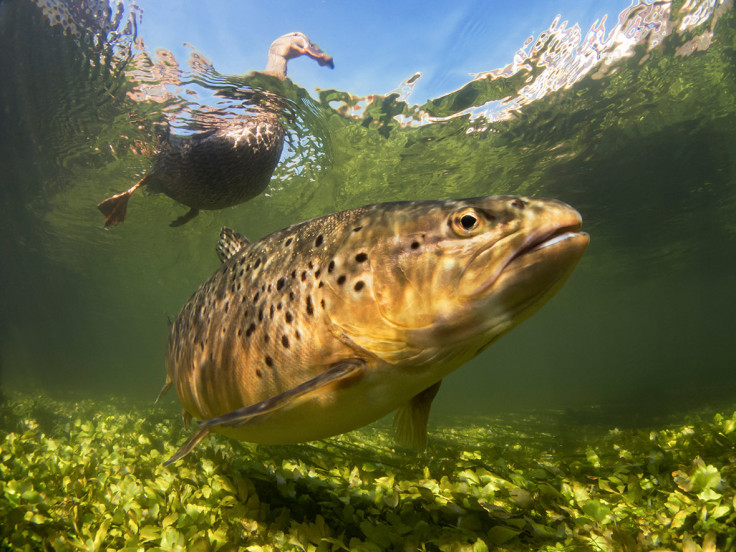
RUNNER UP: 'Tompot looking out' by Trevor Rees (UK)
"This Tompot blenny (Parablennius gattorugine) was found hiding in a hole among the legs of a sea pier. Some of these fish are quite shy while others are rather inquisitive and like to see what's going on. This one was happy to pose for as long as I needed although he/she did frequently disappear for a few minutes every so often before then popping out again. I made sure I had both the fish's eyes facing forward in the same direction and that the head tentacles were isolated against a black background, As they are very popular and very well photographed fish I opted for an off centre composition with quite a lot of negative space to perhaps give a slightly different feel to my take on this fish."
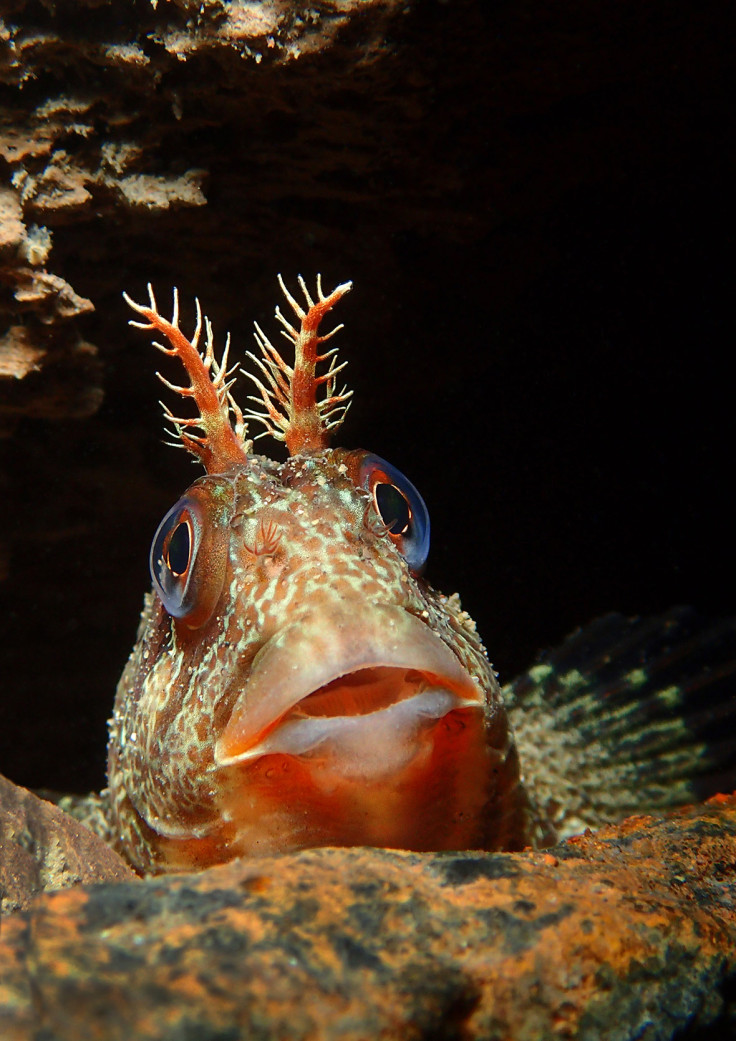
THIRD: 'British native crayfish' by Trevor Rees (UK)
"The British native crayfish (Austropotambius pallipes) is a species now under threat as it struggles to compete against the larger American signal crayfish. The crayfish at this freshwater quarry are all native ones and there are a good number of them to be seen. I found the small form factor of a compact camera ideal for holding at arms length to get a low angle and to get close to an individual that was nicely out in the open. The auto exposure only nature of my camera was restricting but I was pleased to get a light green water background and be able to add a little strobe light to bring out the colour of the crustacean."
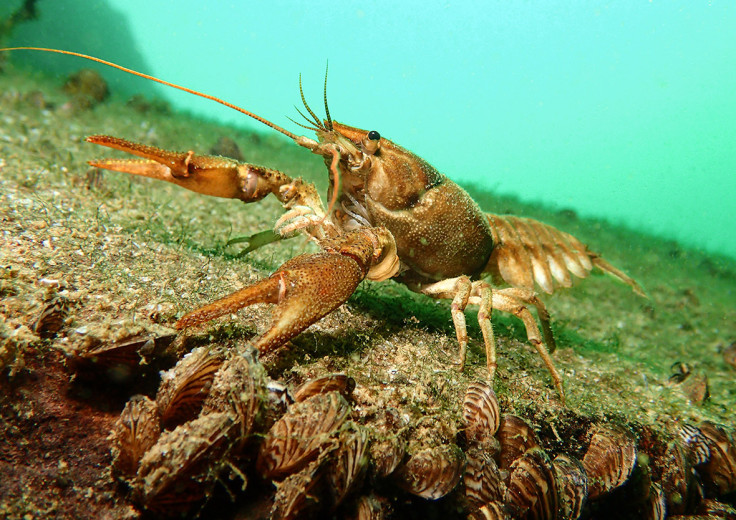
HIGHLY COMMENDED: 'Lobster' by Trevor Rees (UK)
"This lobster (Homarus gamarus) was found sitting deep in a vertical rock crack. The sight of a lobster on any dive is a welcome sight and the Farne islands seems to have healthy numbers of them. After a bit of patience this lobster was inquisitive enough to move forward to allow me enough of a view to get the shot I wanted. This was an occasion where I was fortunate to be able to make use of the small form factor of the compact camera to get in close enough and to be able to shoot with the camera in the portrait orientation to get a portrait format image."
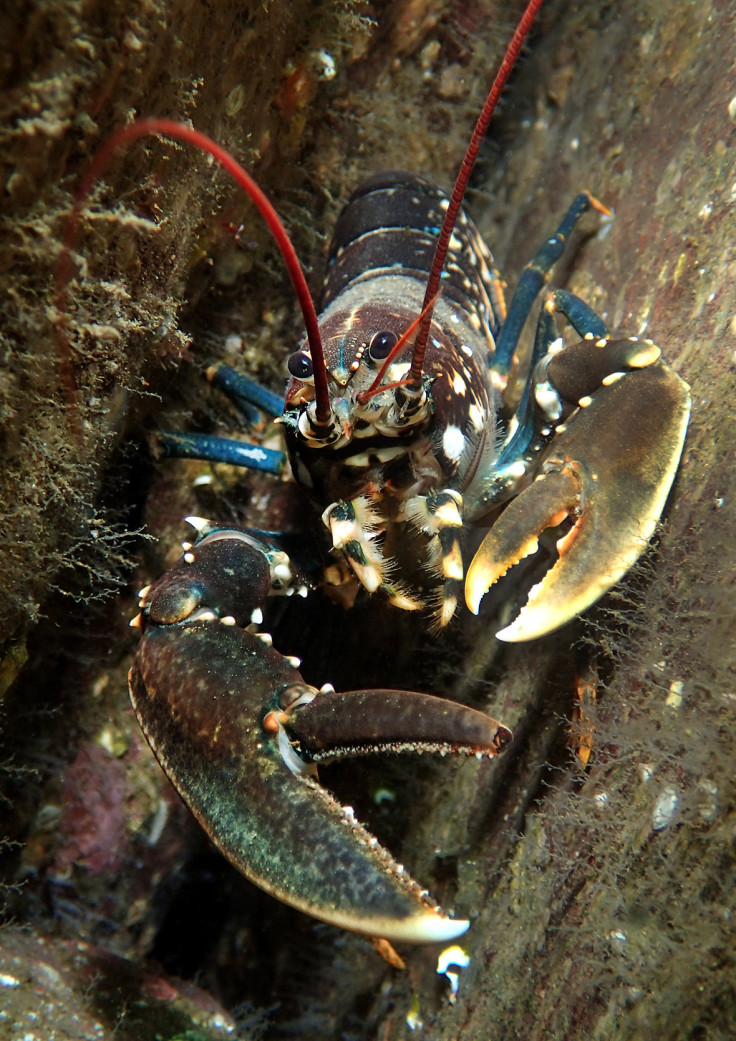
HIGHLY COMMENDED: 'Pike on the move' by Trevor Rees (UK)
"This pike (Esox lucius) was photographed in a flooded freshwater quarry on a busy Saturday morning at a site heavily used for for diver training. I found an area that had reasonable visibility and had having a number of large pike lurking. I did not have long to get the image before the water clarity was quickly ruined by other divers finning by and stirring up the silt which then scared the pike away. I decided to add a feeling of movement in the image by using a zoom blur filter effect with Photoshop, which has also helped to mask a some of the particulate matter in the background."
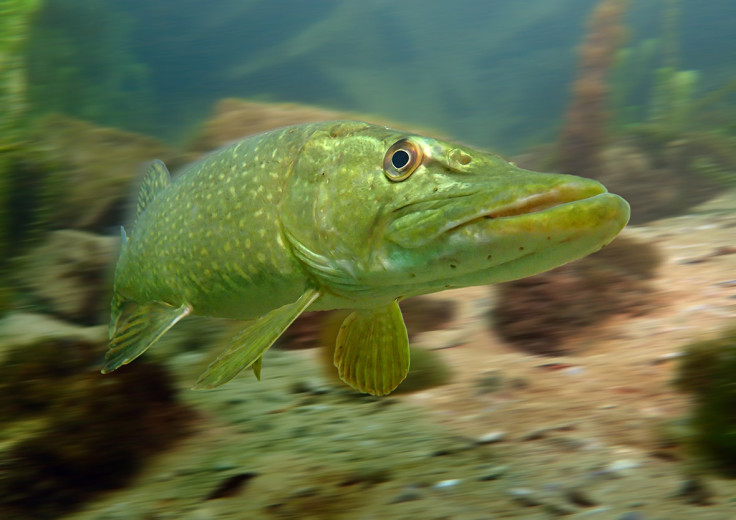
HIGHLY COMMENDED: 'Pink fins taste much better' by Sara Bowring (UK)
"Taking this photo made me realise that its not always what is in front of you at the time. While I was taking a photo I felt a tug on my fins and performed a maneuver that I could never achieve on land and took this photo whilst upside down and through my legs, not expecting to get an image let alone one that sums up my whole trip to the Farne Islands and playfulness of these graceful seals."
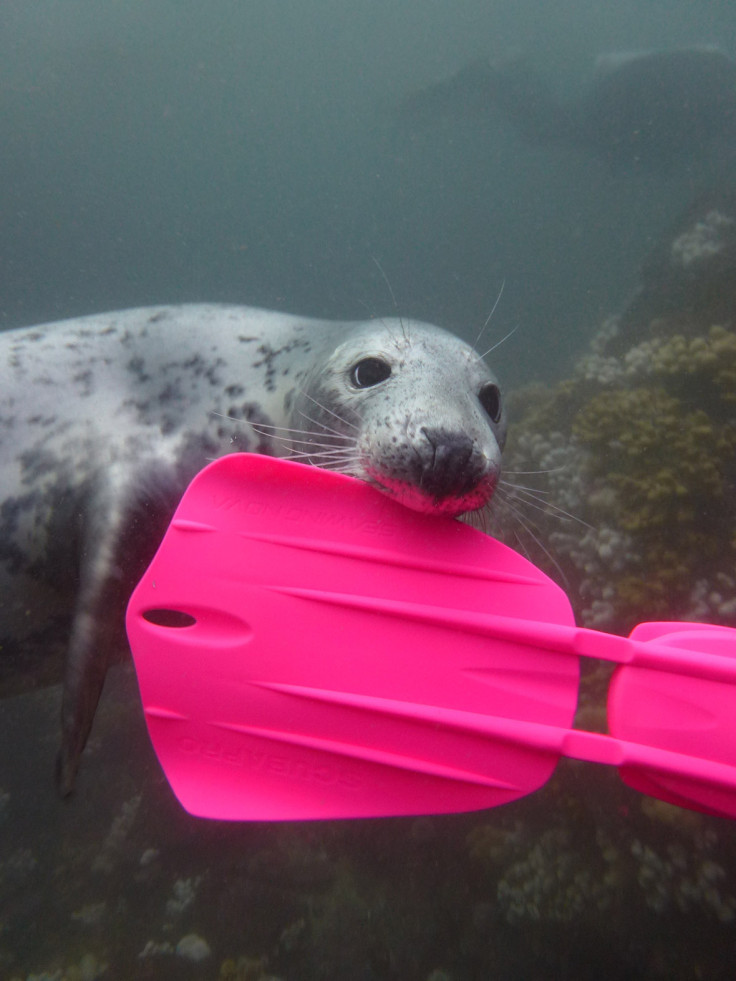
HIGHLY COMMENDED: 'Hello give us a kiss' by Sara Bowring (UK)
"Seal's both Grey & Common have one of the largest parts of my diving heart. I am a Marine Mammal Medic with BDMLR that is a charity that rescue's the young, abandoned and sick seal's all over the UK. So going to the Farne Islands and interacting in their natural environment waiting and wondering if they will come close enough just to get that 'real true photo' is the best feeling in the world."
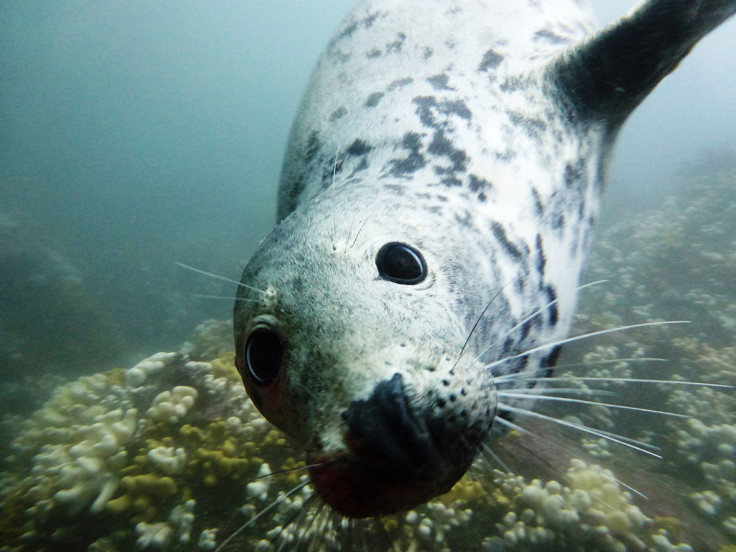
COMMENDED: 'Scilly Seal!' by Nic Faulks (UK)
"The dive was a maximum of 5m in a sheltered bay. Some of the wreck divers stayed on board, so I took my little compact camera and jumped in to see what I could find. I finned through curtains of thong weed, which parted to reveal boulders, sand patches and colourful anemones. Towards the end of the dive, I found an open area of sand, with a couple of boulders. One seal in particular kept coming closer and closer. His acrobatics as he swam close, then flipped away, were quite an amazing sight. My patience paid off, for it was the final encounter when I managed to get this shot, following which he disappeared out of sight."
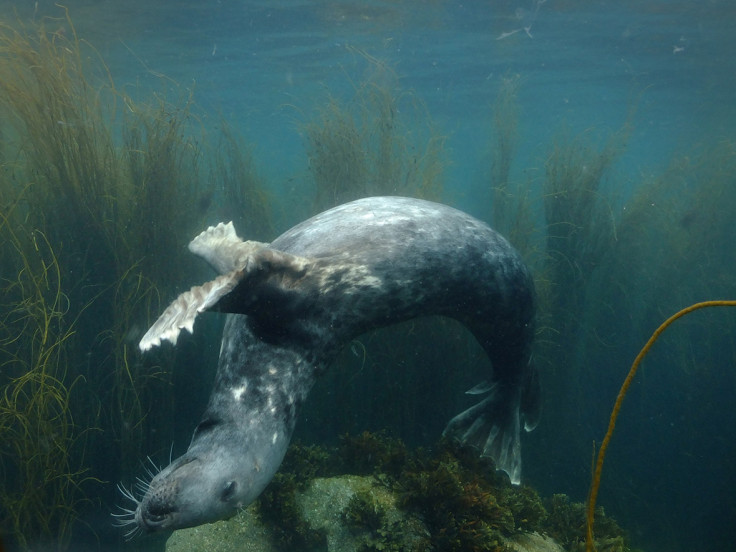
COMMENDED: 'Night Time Stroll ' by Sara Bowring (UK)
"During the day in the shallows of Babbacombe Bay I am positive I saw cuttlefish and this being a very small baby was keen to try and find it again as never seen such a small one before. So knowing that they like to stroll around the sea bed at night to feed better I decided to drag my buddy out for a night dive. It wasn't long before we spotted this beauty in the shallows and was so excited. I don't have a strobe or lights but use the cameras built in flash. I line up using a torch and then turn all lights of and hope for the best as I push the button."
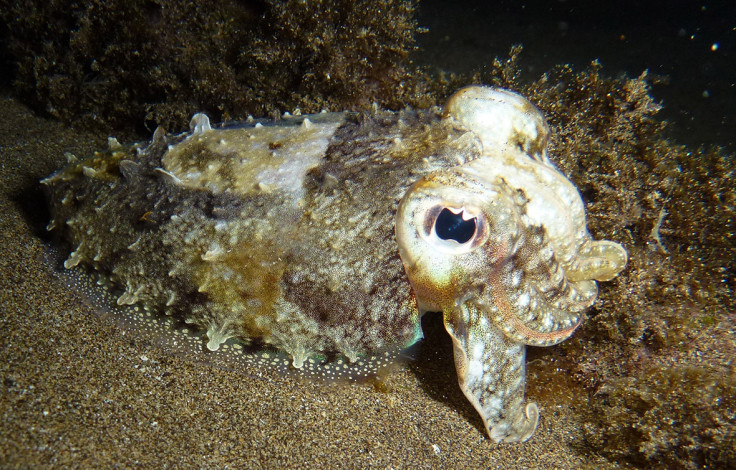
COMMENDED: 'Lazy Day In The Sun' by Sara Bowring (UK)
"For years these beauties have eluded me, I get in the water and they all go on holiday. So you can imagine my excitement when I was taking a photo of something else when I had the feeling I was being watched, and there it was, just next to me, It wasn't a hard one to take a photo of as seemed to just lay there and pose. It was a beach dive with calm shallow water and the sun was shining, doesn't get better than that especially in the UK."
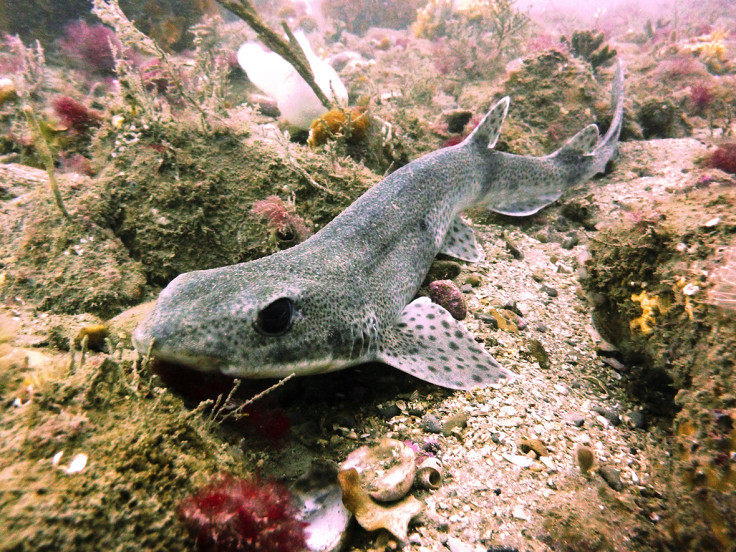
"It was astounding and humbling seeing the quality," said Alex Mustard, chair of the judging panel and the driving force behind UPY. "It is a tough job distilling them down to the very best. Every single image that placed is an amazing moment from the underwater world. And many that nearly made the collection, were almost as stunning. There has never been such strength in depth in underwater photography."
Davide Lopresti, from Italy has named the Underwater Photographer of the Year for his image "Gold", an artistic portrait of a spiny seahorse taken in Trieste, Italy.
© Copyright IBTimes 2025. All rights reserved.






















